Better Sailing


Sailboat Vs Yacht: What is The Difference?
Many boaters use the terms “sailboat” and “yacht” interchangeably when they are actually quite distinct. A yacht is a larger boat or ship that is used for recreational purposes. The term “yacht” is of Dutch origin, and it was initially described as a small, swift sailing vessel used by the Dutch navy to track down and catch pirates. A boat, on the other hand, is a smaller vessel that can range from a fishing boat to a sailboat in size. So, if you’re interested in this topic, this article will compare yachting with sailing in many ways. Like this, you will have a much better understanding of which option is best for you. Keep reading!
Sailboats and Yachts: Meaning
Firstly, it’s important to understand the meaning of each word. Generally, a boat is a form of watercraft that comes in a variety of shapes and sizes. A boat is a watercraft that is small enough to fit on a ship, which is typically less than 1,000 feet long. A ship is a huge vessel with a large carrying capacity that can transport other vessels. The size, shape, and capacity of a boat vary depending on its intended usage. Boats are most commonly employed for navigating places along the water’s edge or inland waterways like lakes and rivers, although they can be utilized on any water source. Boats can be used for a variety of purposes, including providing service to people and vessels on the water, recreational activities, commercial passenger, and cargo transportation across waterways.
So, a sailboat (sailing vessel) is a boat that is propelled primarily by the force of the wind on sails. Keep in mind that the term “boat” can cause some misconceptions about the vessel’s size. People may refer to it as a sailing ship rather than a sailing boat once it reaches a particular size. Also, boats are generally thought to be smaller than ships. A sailboat is a water-borne watercraft whose principal means of propulsion is the wind, which is captured and controlled by triangular-shaped pieces of cloth known as ‘sails.’ On the other hand, a powerboat is a watercraft with an internal combustion engine as its primary source of propulsion.
A yacht is most likely a vessel that is primarily used for personal rather than business purposes. There are yachts that you can hire for a week or more. This might add a little confusion as they are commercially owned but within the hire period, they are used by individuals for leisure purposes. Generally, people usually refer to sailboats as yachts or vice-versa. This is a common phenomenon nowadays, however, there are significantly more sailing yachts than motor yachts at the seaside/marina. If you want to specify a boat that is not largely powered by the wind, use the word motor yacht.
Sailing yachts and motor-powered yachts are the two forms of yachts available today. Yachts range in length from 26 feet to hundreds of feet. A cabin cruiser, or just a cruiser, is a luxury vessel that is less than 39 feet long. A superyacht is typically above 70 feet long. So, what is the definition of a mega yacht? They usually exceed 150 feet in length, but there is no top limit! Note that the world’s largest boat is 728 feet long, or 222 meters.
Let’s now check the main differences between a sailboat and a yacht:
Sails and Motor
The boat may be powered purely by the wind or by one or more inboard or outboard motors, depending on the model. While some larger boats may have very massive engines to provide genuine speed on the water, most yacht engines are far less powerful. Yacht engines are substantially larger, can produce far more power – up to 800hp in some circumstances – and can go many further distances.
If you’re searching for a vessel that’s easier to operate, you could argue that a yacht is a superior option. Sure, the computer components are more complicated, and there is more to manage, but sailing will be simpler. In stormy weather, managing a sail can be tricky. From inside the cabin, you can’t manage your sails. You may, however, operate your yacht from the cabin.
It’s a fact that sailboats will always have sails. After all, it’s their primary source of propulsion. The nail is what propels the boat forward by harnessing the wind. So long as the weather permits, sailing can be done anywhere, at any time. Yachting, on the other hand, has its own set of restrictions. A yacht will usually lack a sail, which can be viewed as a good or negative aspect, depending on your perspective.
The advantage of having a sail over only an engine is that you don’t have to worry about running out of fuel. Fuel is not only costly but also inconvenient and pollutes the environment. When on long voyages, you must always keep an eye on your fuel levels, or you risk breaking down at sea. The great thing with sailboats is that as long as there is wind, a sailboat can sail. If you have an extra sail onboard, you should be alright regardless of what occurs. You have a significantly lower chance of being left stranded at sea.
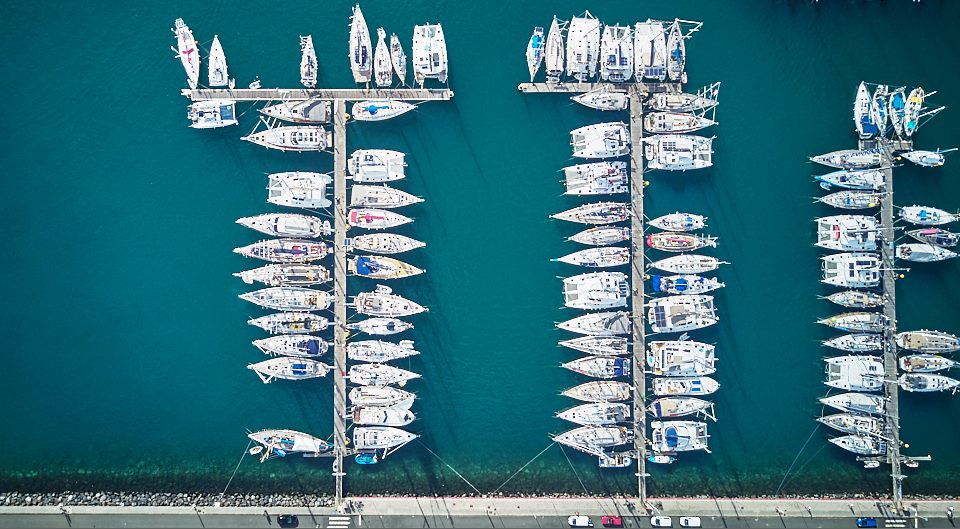
>>Also Read: Sailboats Vs Powerboats: Why Sailboats are Better
Size Matters
The size difference between a yacht and a sailboat is one of the most significant ones. Most of the time, a sailboat will almost certainly be smaller than a yacht. Of course, some sailboats are larger than others, but if we’re talking about average sizes, a yacht will be larger. The reason that size counts so much when deciding which boat to buy is that the available space is limited. So, if you opt for space note that the larger your boat is, the more space you’ll have. This may seem self-evident, but it is one of the most crucial aspects of your boat to which many people forget to give due consideration.
Generally, when it comes to boats, size will always matter. Except in cases where someone prefers overall better performance and speed. But, keep in mind that almost everything you do will be influenced by the size of your boat. The smaller the boat, the less storage space you have, the less space you have for emergency supplies, and even the less space you have for yourself. Regardless of the size of your boat, your sleeping quarters will most certainly be small. Also, depending on your height, every inch of a room may be crucial.
When there are more people on your boat than just you, size matters the most. If you intend to live alone on your yacht, you will have a significant space advantage. If there are three persons on board, you probably going to need more equipment and devices for cooking or for emergencies. All of this suggests that the sleeping space is the most significant distinction between living alone and living with people. If you live alone on a yacht that can sleep four people in theory, you will have a lot more storage and consequently space.
People on Board
The extent to which the crew will influence your decision is mostly determined by your budget and the size of the vessel you are considering buying. Meaning that if you’re intending to buy a sailboat, you won’t need any crew. Except for your family/friends that live on your boat with you, you basically are the entire crew. However, if you own a yacht, it’s an entirely different scenario.
If you intend to live aboard your yacht, you may require the assistance of one or two crew members. There will be plenty to do even if you are the most essential member of the team, i.e. the captain. This is because you might haven’t already mastered things like navigation, maintenance, plumbing, and engineering. So, a yacht often requires a complete crew to assist with navigation, maintenance, electronics and engineering, repairs, and sometimes even stewards to attend to the passengers.
In other words, having a sailboat means that you can take care of everything yourself. There are only a few computer components that will need to be repaired, and you are unlikely to have an engine. Repairing a sailboat isn’t easy in and of itself; it’s just easier for one person to handle. Meaning that it’s far easier to replace a sail than it is to fix an engine. In bad weather, a small sailboat is just easier to monitor than a large yacht. At the absolute least, another set of eyes will be probably required when sailing with a yacht.
Price also Matters
In general, yachts tend to be more expensive than sailboats. Occasionally, a great deal more. For a variety of factors, the most important of which are materials, design, and construction techniques. Note also that a boat’s price is likely to rise as it becomes more modern. Although this isn’t always the case, it is the vast majority of the time. If money is a key factor in deciding which boat to buy, here’s something to think about: just because a yacht is more expensive doesn’t mean you shouldn’t have one. If you have the cash, knowledge, and you know the kind of sailing you will be doing then go for a yacht!
Note also that a sailboat can be outfitted with a variety of amenities and conveniences. But, the sailboat doesn’t always include these features. This will mostly depend on the type of sailboat. As a result, buying a basic sailboat can save you a lot of money. However, most yachts will provide high end amenities. As a result, a motor yacht will cost significantly more than a regular sailboat. Sailboats are also smaller than yachts, which means you have a larger selection of less expensive boats to pick from when making your purchase. But, yachts often start in the six-figure range and can reach millions of dollars depending on the yacht’s size, age, and build quality.
Maintenance and Repairs
Yachts are frequently more expensive to maintain than sailboats. Meaning that boat engines require a great deal of upkeep, and the expense of fuel can be prohibitive for many individuals. For example, did you know that a gallon of diesel fuel in a yacht may only allow you to travel less than 1 nautical mile? If you’re going on a long voyage out to the sea, you can end up spending a lot of money on fuel. A sailboat, on the other hand, can take you wherever you want to go with very little fuel. Bear in mind also that a yacht’s insurance is more expensive than that of a sailboat. One of the main reasons is because it is classified as a yacht.
In addition to the boat’s price there are some other things to consider. The most important one is maintenance and repairs. A boat will always need these and it might need them once per month or once per year. It depends on the kind of repairs and on the way in which you “treat” your boat. Also, if you’re buying a used sailboat, you will need sometimes more research and more money for upgrades. It will be repainted, restored, and upgraded, although it will remain the same size. You should approach buying a boat in the same way that you would with a car. So, according to the size and kind of boat you want to buy, it’s important to keep in mind the price and extra costs as well.
While advanced marine electronics and navigation systems are available on some boats, they are more of a must for yachts. When doing transatlantic voyages, it is critical not only to be able to navigate with precision but also to be able to identify other boats or objects that you may not be able to see, as well as to comprehend your vessel’s performance.
When it comes to technology, it’s not just about whether you’re choosing a sailboat or a yacht. The age of the specific vessel is also something to consider. A sailboat that is more than ten years old may not be as technologically advanced as a brand new sailboat. Better technology can offer a lot of opportunities for you if you decide to buy a yacht. First and foremost, it can make working on your boat much more convenient. There’s no reason you couldn’t work remotely from your boat if you have the ability to set up a functional office with wifi.
Technology also brings up a lot of new possibilities for you when it comes to the act of sailing. A sailboat could traverse the Pacific or Atlantic, but it would be rather difficult. On the other hand, with a yacht, it can be a lot easier. In comparison to a sailboat, your yacht will have advanced navigational systems, warning and guidance systems, and many more safety features.
Sea, Lakes, or Rivers?
Bear in mind that in shallow waters, large yachts are unable to sail. A sailboat is a way to go if you plan on sailing in areas with shallow waters. In the Caribbean, for example, a yacht might be difficult to navigate. At the very least, it’ll be more difficult than sailing. A yacht, on the other hand, may travel to far more places than a sailboat.
A small sailboat might theoretically sail across the Atlantic. However, it can be quite risky, and your boat might not be able to withstand the strong winds and waves. Furthermore, if you’re aboard a sailboat, you can be the only one on board. This means that if the worst happens, far out at sea, there will be no one to aid you. You can do it, of course, but it is risky.
So, smaller boats may normally operate in calmer seas such as lakes, rivers, and shallow harbors. Larger boats, usually between 20 and 30 feet long, can equally navigate rougher ocean seas. A yacht, on the other hand, can sail in deeper ocean waters and handle more choppy seas. Yachts are significantly more ideal for lengthy ocean voyages due to their bigger size, high-tech electronics and guidance equipment, weather protection, and a variety of other characteristics.
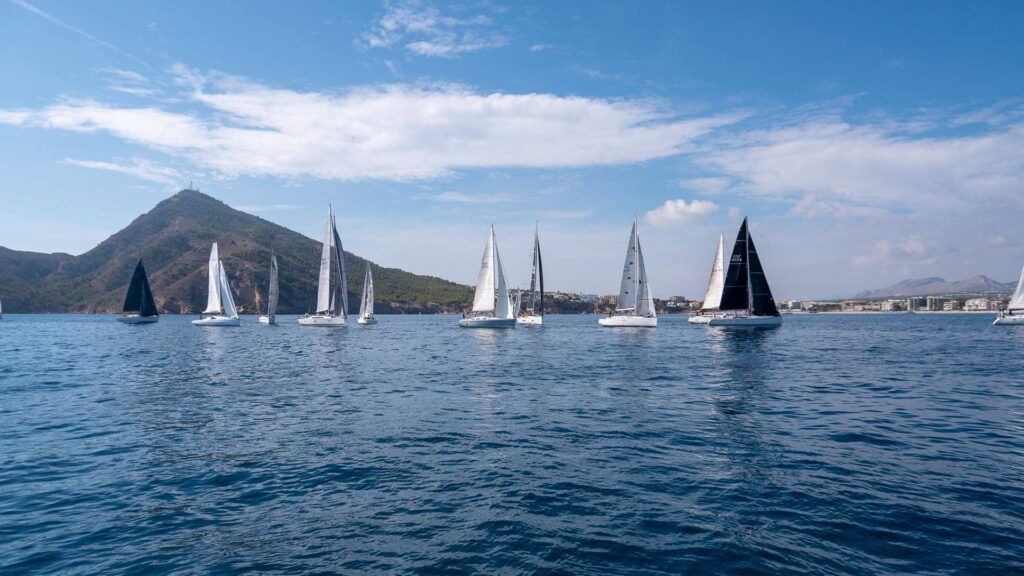
>>Also Read: Sailing Vs Boating: Why Sailing Is Better
Sailboat and Yatch Construction
Depending on the anticipated scale of production, sailboat makers can fabricate their own parts or order them. Masts, sails, engines, and metal fittings are common items provided by specialty vendors. Boatbuilders, on the other hand, create their own fiberglass hulls, using Gel coat polyester resin, a catalyst for the resin, woven fiberglass roving, and fiberglass. Wooden hull manufacturers create and shape their own wood in the same way. Note that the main building materials used in boat construction are aluminum, metal, wood, and fiberglass. The unique structure of each material offers a different design and usage as well as additional features to the way in which the boat is built.
Material considerations are important, whether they affect the cost or the durability of the product. Fiberglass, carbon fiber, and metals such as titanium will also be used to construct a boat. On the contrary, a sailboat will most likely be composed of wood or fiberglass. So, in case you value safety and sturdiness above all else, and money isn’t a big issue, a yacht will be significantly safer for you.
The material can also influence the way in which you make repairs. For instance, a wooden boat is much easier to repair than a metal boat. You can make some simple and quick repairs using wood, and they’ll probably last till you get to a marina. To do major repairs on a yacht, you’ll need a lot of specialized equipment and knowledge. Moreover, you may need to ask for a crew member to help you with this.
Sailboat Vs Yacht – Summary
As you can see there are many differences between a sailboat and a yacht. Nowadays many people tend to confuse or don’t be aware of the exact meaning and differences of these vessels, and it’s normal. But, we, as sailors, have to know the differences in order to understand which kind of boat is right for us. For example, if you want big spaces, luxury, or intend to liveaboard then you should opt for a yacht. But, if you want to experience the true joy of sailing, sail anywhere without worrying about polluting the environment or spending too much on fuel, then go for a sailboat! It will entirely depend on your needs and preferences so weigh the pros and cons of each one before making the decision.
In any case, I hope that you have now clarified the differences between these two and that you will make the right choice. I wish you all safe & enjoyable voyages!
Peter is the editor of Better Sailing. He has sailed for countless hours and has maintained his own boats and sailboats for years. After years of trial and error, he decided to start this website to share the knowledge.
Related Posts

Atlantic vs Pacific: Which is More Dangerous for Sailing?

The Ultimate Guide to Choosing the Best Fishing Line for Trolling

Lagoon Catamaran Review: Are Lagoon Catamarans Good?

Best Inboard Boat Engine Brands
- Buyer's Guide
- Destinations
- Maintenance
- Sailing Info
Hit enter to search or ESC to close.

My Cruiser Life Magazine
Yacht vs Sailboat – A Definitive Guide
What exactly is a yacht, anyway? Does it have to be a motor boat? But what about large sailing yachts?
The term is confusing because it is used differently in different places. Sometimes, it’s a term only reserved for large motor yachts with multiple crew member teams.
Here is a look at my observations. You might find that the lines are different in your harbor, but this article should get you started.
Table of Contents
- Sailboat vs Yacht – What’s the Difference?
Six Things that Make It a Yacht
So what’s a yachtie, then, sailing yacht vs motor yacht, types of yacht — what makes it a megayacht, modern yachts, classic designs.
- What about Yacht Racing?
Sailing Yachts or Motor Yachts
Faqs – motor and sailing yachts vs sailboats.
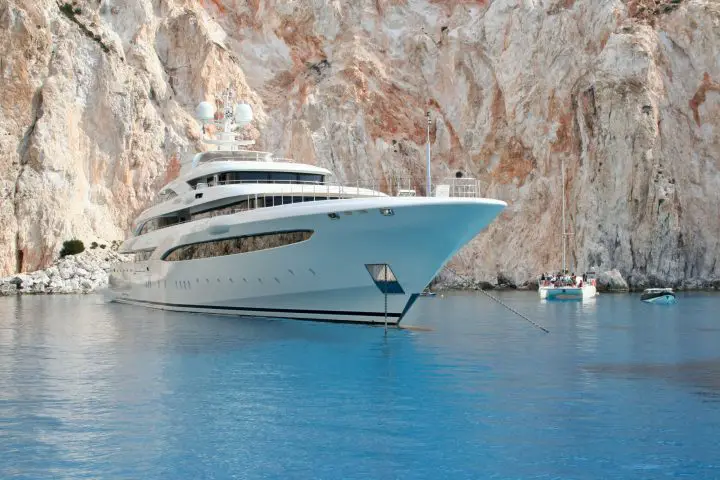
Sailboat vs Yacht – What’s the Difference?
Before diving in, it should be noted that there is some regional variation at play. For example, American and British sailors use the word yacht very differently.
First, the American definitions. From the Merriam-Webster dictionary, here are how sailboats compare to yachts.
Sailboat – A boat usually propelled by sail sailboat Boat – A small vessel for travel on water Yacht – Any of various recreational watercraft, such as a) a sailboat used for racing, or b) a large usually motor-driven craft used for pleasure cruising Merriam-Webster Dictonary
So right away, we can see a few trends that play out in the real world. For one, any term with the word “boat” is inherently generic. It could be a fishing boat, a work boat, or a pleasure boat. Likewise, it could be a sailboat or a motorboat.
On the other hand, a yacht is a special kind of boat. It is always for recreational and not commercial use. Sometimes it’s a sailboat used for racing, and sometimes a motorboat used for cruising.
From my personal experience on the water, I don’t disagree with this definition, but it leaves out a lot of nuances.
Across the Pond, the use of the word yacht is slightly different. In British usage, the words “yacht” and “sailboat” are used more or less interchangeably, with more sailors tending toward the word yacht. Here’s the definition according to the Cambridge English Dictionary.
Yacht – a boat with sails and sometimes an engine, used for either racing or traveling on for pleasure Cambridge English Dictionary
This sounds like the definition of a sailboat by US usage to my ear. But this is precisely how many Brits I have met in my travels refer to their boats—er, yachts.
Besides the dictionary definitions, we could look at how the term is used in the publishing world. For example, one of the most popular UK-based magazines is Yachting World . The magazine covers cruising boats, global sailing destinations, around the world races, and general sailing techniques. Its nearest US competitor is called Cruising World.
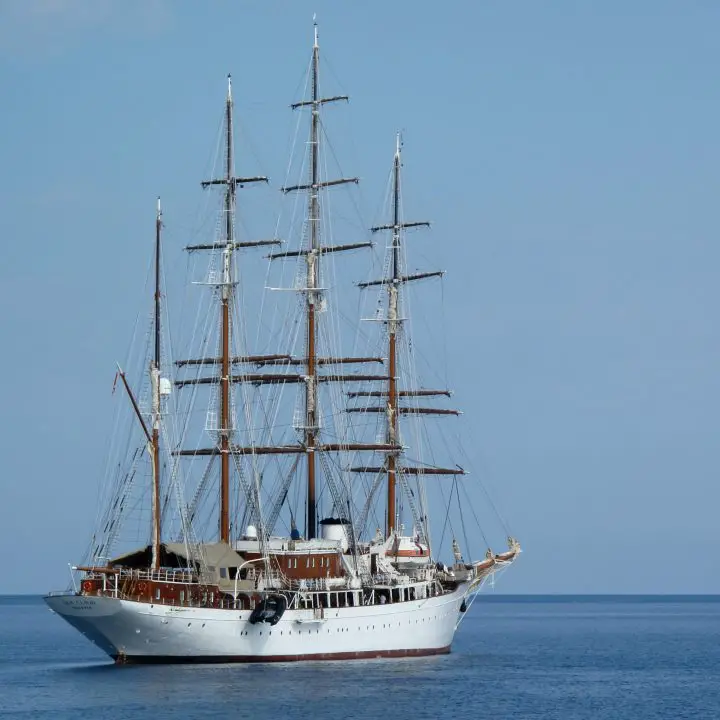
As a boater in South Florida, I became more aware of the differences between a boat and a yacht. You cannot navigate the waters between Fort Lauderdale, Palm Beach, and Miami for long without noticing a few other things that will qualify you as a yacht.
1. Yachts are nearly always operated by a professional crew who act as hosts for the owners and guests. There’s always a captain and chef, and usually stewards and deck hands too.
2. Yachts are flashy—they look expensive, and they are expensive. They shine, they’re always washed, and their wood and stainless glisten with perfection. After all, they have a full-time crew to tend to all of that.
3. While motor yachts are more common, there are plenty of beautiful sailing yachts on the water as well.
4. Yachts tend to be big. They need to be big enough for guests and crew to be comfortable. Plus, many are owned by business owners who use them to entertain.
5. Yachts spend much of their time with no guests/owners on board. Instead, the crew moves the yacht from one place to another, and the owner flies in to enjoy a few days a month onboard.
6. Many yachts are available for charter. While one person might own it and use it, they don’t spend all their time onboard. So when it’s still idle, it and its crew are leased out for days/weeks/months at a time.
Even within the subset of the motor yachts, there is significant variation and room for definition. To illustrate, some boats are designed to be sleek and modern, with the stately look of a yacht.
The term yachtie is commonly heard in port cities around the world as a person who gets off a yacht. Initially, this term was used only for wealthy owners or their guests. However, if you’re in a place where “yacht” means smaller boats, then any sailboat owner could be called a “yachtie.”
Nowadays, though, the term yachtie also could refer to the crew. Bravo TV’s Below Decks reality series focuses on the adventures and misadventures of the crews on these sorts of yachts.
More often than not, yachts are motorboats. But they aren’t just any motorboat. They are often sleek and fast ones that look like they just blasted out of the newest James Bond film.
There are also plenty of other styles of yacht on the ocean. Yachts take many shapes and forms since the best naval architects design them to suit whatever their clients want to do.
For example, some yacht owners use their boats to explore the Seven Seas. To do this, they might commission a custom expedition yacht or convert an old research vessel, fishing boat, or tugboat. These vessels are great for getting off the beaten track and taking any long trip.
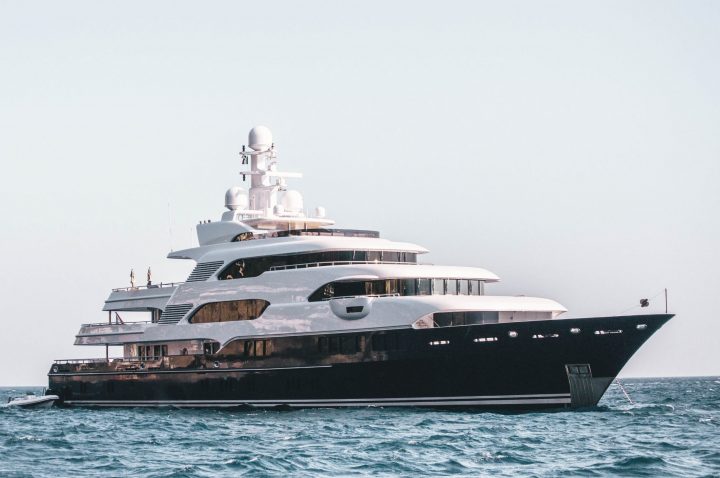
And similarly, some yacht owners want to sail. Some enjoy sailing for sailing’s sake, and others want their floating mansions to produce a smaller environmental impact by cutting down on their use of fossil fuels.
There are classic sailboat superyachts, like the three-masted schooner EOS . The EOS is the second-largest pure sailing yacht in the world at 305 feet (95 meters) long. She was launched in 2007 and is owned by movie billionaire Barry Diller and his wife, fashion designer Diane von Fürstenberg.
But you can’t compare the motor yacht vs sailing yacht without mentioning some of the other ultra-modern takes on the classic sailboat. The Maltese Falcon is a well-known sailing superyacht with three masts. But unlike the conventional schooner rig found on the EOS, the 288-foot (88-meter) Maltese Falcon has DynaRig technology . It looks like a square-rigger from the 1800s, but the masts can rotate, allowing it to sail upwind.
And for those who are still pondering sailing vs motor yacht design, you can’t miss Sailing Yacht A . Sailing Yacht A is sometimes noted as the largest sailing yacht in the world, but due to its unusual design, it is actually a “sail-assisted yacht.” In other words, this boat has sails, but it needs to run the motor to make way—the sails only help the motors.
How Big Is a Yacht?
With varying meanings worldwide, no single definition for the word yacht exists. Many brokers and charter companies loosely define a yacht as being at least 80 feet (24 meters) long.
In an industry where the lowest entry-level model needs to be big, luxurious, and fancy—how do different naval architects and boat makers differentiate themselves? In other words, how can a yacht be more than just a yacht?
The answer, of course, is to be a SUPER or a MEGA yacht. There’s no agreed-upon definition of what precisely these terms entail, but make no mistake–it takes a big yacht.
Worth Avenue Yachts, a global yacht broker and charter specialist company, postulates that a superyacht is at least 78 feet long (24 meters).
Furthermore, mega yachts are even grander. They start around the 200-foot (60-meter) line and keep getting bigger from there. The largest megayacht in the world is the 592-foot (180-meter) AZZAM . AZZAM was launched by Lürssen Yachts in 2013 was built for the President of the United Arab Emirates.
Yacht Aesthetics
So we’ve touched on the fact that yachts are usually pretty big, and in some cases really, really big. But there’s another thing that sets them apart from the typical sailboat, too. Yachts look different.
Generally, there are two aesthetics or looks that yachts take on, forming something of a motor yacht debate. Of course, this isn’t an inclusive list. Many designers work to make a statement with their yachts. The look of the finished vessel is a statement and an advertisement for the builder.
There are many yachts built that are designed right from the drawing board to turn heads. The most common way they do this is by making them modern and sleek, even futuristic at times.
Designers and builders put the latest technologies into yachts to appeal to early adopters of new technologies. What CEO or celebrity doesn’t want to own the world’s fastest yacht ?
And then there are futuristic-looking ones with forward-thinking designs. Boat International collected some of the craziest-looking yachts that are worth a look.
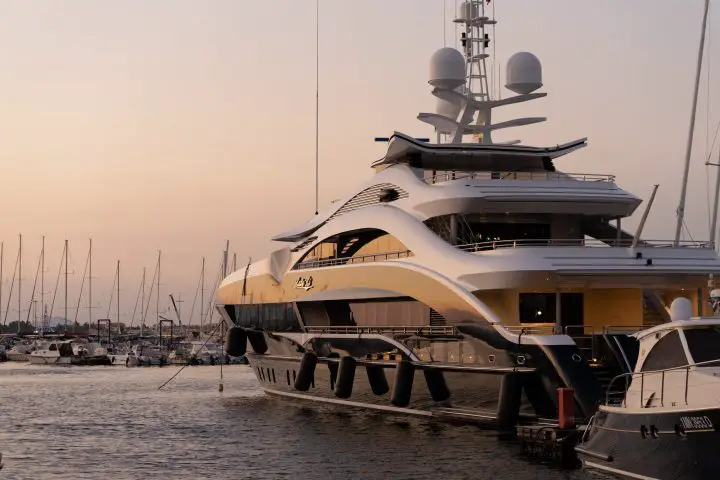
The yachts above get their title as yachts thanks to their value and size. But there’s another classification that you should consider—those yachts that get their name for their air of traditionalism.
Perhaps they are well-cared for or restored wooden hulled yachts from the 1920s or 30s. Many of these classics are sailing yachts , but that isn’t always the case.
In some cases, they are modern fiberglass or metal-hulled boats built recently and designed by contemporary designers. But their owners wanted that classic yacht aesthetic, so they created something that appears older than it is. Here’s a look at some of the nicest classic yachts out there.
What about Yacht Racing?
The older, more traditional British use of the word yacht seeps into everyday American English in a few places.
They’re more common on the international stage, so beyond the everyday use of yacht terms in the US, these particular uses harness a more global view of the word.
One such example is in the term yacht racing. Yacht racing sounds fancy, and it usually is, but it is entirely about sailboats. Yacht racing is usually done at a yacht club, another term that focuses on an older use of the word.
In the heydays of the yacht club, the line between the sort of crewed megayachts you see today and the person sailboat was blurrier. Fewer people had boats, and those boats that the wealthy could afford were divided between large crewed vessels and those small private boats kept at clubs. And, of course, one of the favorite activities at the yacht clubs was yacht racing.
Yacht clubs are still a thing, but they are less a part of everyday boating in the US than they used to be. Yacht clubs range from a local, passionate small boat sailing community to exclusive, elite social clubs with little to do with yachts.
Yacht racing is an international sport, although even the Olympics refer to it now as “sailing.” The oldest trophy in sports is the America’s Cup , and the competition for it is the pinnacle event in yacht racing.
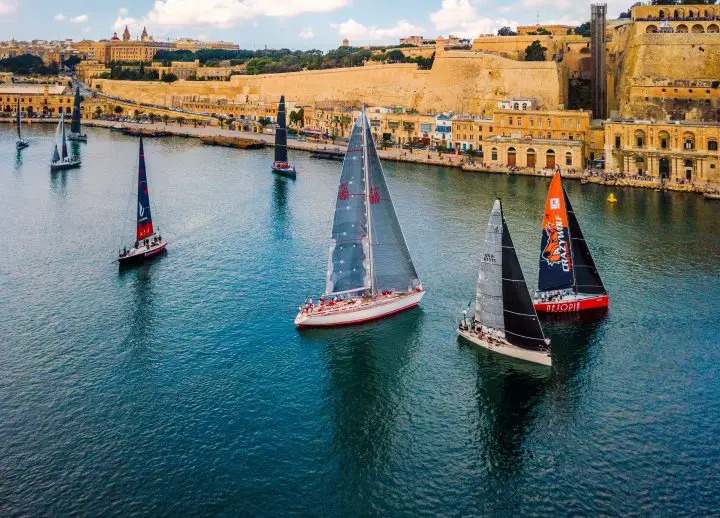
So how do you tell a yacht from other boats? It depends on several factors, but unlike a lot of things in boating, there really isn’t a right or wrong answer. If you want to call your new 20-foot pontoon a yacht or even a ship, go right ahead. However you want to enjoy life, the weather, sun, wind, or adventure, only one thing is for sure. Owning a boat makes it better!
To learn more about other boats and their comparisons, check out: Catamaran vs Pontoon
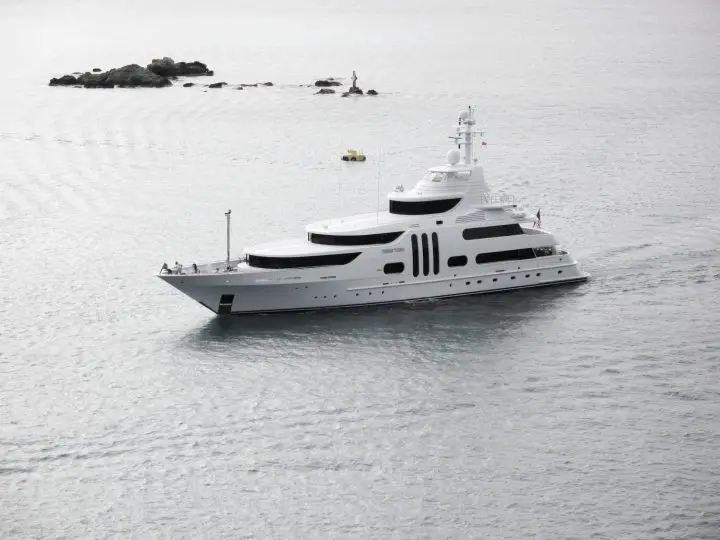
At what point does a sailboat become a yacht?
There is no definitive line where a sailing boat can be called a yacht. To some extent, you can use the word sailboat to describe any private, recreational sailing vessel. This is how the word is used in many parts of the world.
In the United States, the word yacht is usually reserved for crewed luxury vessels. To count as a yacht by this definition, the boat would need to be very high-end, sleek, and expensive. In short, it’s probably not a yacht if it’s under about 80 feet or so.
Are yachts or sailboats more expensive?
Yachts are more expensive, but it’s all in the definition of the word. In the US, the understood definition of a yacht is a luxurious sailboat or motor yacht. More often than not, yachts are big enough to require a professional crew.
On the other hand, a sailboat is any vessel that uses sails for power. So a yacht could be a sailboat, but not all sailboats are yachts. By the US definition, most sailboats are small and far from the lavish luxury you’d find on a yacht. But in some parts of the world, “yacht” is used interchangeably for a sailboat of any value.
Is a 40 foot sailboat a yacht?
The answer depends on where you are from. In parts of the world heavily influenced by British English tradition, the word yacht is often interchangeable with sailboat. If this sounds right, then a 40-foot sailboat could definitely be a yacht.
But in the US, the word yacht is usually reserved for large, lavish, and expensive vessels with professional crews—the types owned by celebrities and the super-wealthy. If this sounds more like your neighborhood, chances are a 40-foot sailboat is just a sailboat. On the other hand, if it doubles or triples in size and gets a crew, it might be bordering on yacht territory.
Is a sailing yacht cheaper than a yacht?
In general, the purchase price of yachts are roughly equal. While sailboats have more rigging and equipment, motor yachts have larger engines, so the prices are closer than you might imagine. There are too many variables to generalize when it comes to operating costs. In general, though, a fast-moving powerboat will always cost more than a slow-moving sailboat due simply to fuel costs.
If you’re thinking about chartering and want to compare the prices of sail versus power, companies like The Moorings Charters allow you to browse various destinations and boats. For example, a one-week charter on a 42-foot sail catamaran in the BVI starts at around $9,400. For comparison, that same charter on their smallest power catamaran, a 43 footer, starts at $11,070.
Matt has been boating around Florida for over 25 years in everything from small powerboats to large cruising catamarans. He currently lives aboard a 38-foot Cabo Rico sailboat with his wife Lucy and adventure dog Chelsea. Together, they cruise between winters in The Bahamas and summers in the Chesapeake Bay.
Yacht vs Sailboat: What's The Difference?
Explore the key differences between yachts and sailboats in our latest blog post. Perfect for travelers deciding on their next nautical adventure.

The world of boats is complicated to decipher because of how many types, models, and brands exist. Yachts and sailboats are two essential types of boats that are immediately recognizable by anyone. With that said, the yacht vs. sailboat debate ultimately comes down to several distinguishing factors between the two.
The main difference between yachts and sailboats is that sailboats have sails and yachts don’t. Sailboats are also smaller than yachts, feature fewer amenities, and cannot move quite as fast. Yachts are also much more expensive to purchase and maintain, and maintenance costs 20% of the initial cost each year which can cost tens of thousands of dollars.
It’s much easier to transport a sailboat than a yacht because yachts have to be shipped on a cargo deck. Conversely, you can attach the average sailboat to a trailer and tow it to a port. Follow along as we highlight the key differences between yachts and sailboats.
What Is The Difference Between a Yacht And a Sailboat?

The main differences between yachts and sailboats come down to size, amenities, and build . They serve the same purpose, but yachts and sailboats differ quite a bit when it comes to design. While not interchangeable, many prospective buyers struggle with whether or not to buy a yacht or a sailboat.
The yacht vs. sailboat debate has been discussed for decades, and it is ultimately subjective. However, many key differences can sway your opinion before you make a big purchase. Let’s take a look at the difference between yachts and sailboats and see why they matter.
Sails are the most immediately clear difference between yachts and sailboats. Sailboats always feature sails, but that’s not usually the case with yachts. The sail on a sailboat helps propel the vessel and is useful whether your boat has an engine or not .
Standard yachts lack sails because it would alter their appearance. Yachts are supposed to look sleek and luxurious which wouldn’t work as well with a sail. With that said, sailing yachts feature sails and are more often used for racing than cruising.
One of the downsides of traditional yachts is that you don’t get the aerodynamic boost that you would get with a sail . If you have a high-powered engine, this isn't a problem, but it will have to work harder without a sail under poor weather conditions.
The average sailboat is smaller than the average yacht. For example, the average yacht measures 78 feet long and the average sailboat measures 30 feet long . Yachts can be as small as 40 feet long or they can even exceed 100 feet long.
The world’s largest yacht measures 511 feet long and it is unsurprisingly owned by a multi-billionaire . Both yachts and sailboats vary in width depending on the floor plan and how many cabins they feature. Sailboats are generally slender because they feature a small galley and don’t typically include a cabin.
A superyacht is defined as a yacht that is 79 feet long or longer. However, you won’t find many superyachts out on the sea because they cost at least $3,000,000 in most cases.
Yachts are almost always much more expensive than sailboats. The difference in cost comes down to the many amenities that yachts are known for as well as the motor and size. Yachts start at $500,000 on the low end, but they can exceed $10,000,000 for superyachts over 79 feet long .
The more expensive a yacht is, the more expensive it will be to maintain because of the fuel demands and part replacements. There is more variety in cost when it comes to sailboats because they are a broad category of vessels. For example, a sailboat with no motor will cost thousands of dollars less than one that is motorized.
A motorized sailboat can cost as much as $250,000 or more whereas one without a motor may only cost $3,500 . Luxury sailboats with cabins can cost $500,000 but without the powerful performance of a yacht. With that said, sailboats cost less to maintain so even buying a high-end vessel may be a worthy investment.
Yachts have a higher capacity than sailboats because of how much bigger they generally are. There are often multiple decks on a yacht which makes it easy to host a large group of guests. Standard yachts can only accommodate 10-12 people, but large superyachts can hold more than double that in some cases .
Sailboats can typically hold 5-10 people, but it depends on the size of the vessel. You can calculate the capacity for a sailboat or yacht by multiplying the length and width and then diving that number by 15. Otherwise, you can simply refer to the capacity as recommended by the manufacturer.
It’s worth noting that boat manufacturers can only provide approximate estimates for capacity. They base the capacity on an average of 150 pounds per person, but that doesn’t apply to everybody.
Yachts are superior to sailboats when it comes to amenities in most cases. Sailboats sometimes feature a few amenities, such as a cabin or bathroom. However, yachts are considered luxury boats, so they are more likely to include special amenities such as built-in speakers and even TVs in some cases .
Some yachts even feature swimming pools and hot tubs, but they come at a premium price. They typically feature at least one deck to accommodate guests and some even feature helicopter pads . You won’t find nearly as many amenities on a sailboat because sailboats are more for practical use.
Larger sailboats may include a private deck and retractable sunshade. Otherwise, there isn’t usually enough space on a sailboat to include luxury amenities such as movie screens and infinity pools.
If you’re looking for a boat with comfortable quarters, then a yacht is ideal for you. Sailboats feature quarters in some cases as well, but yachts specifically emphasize comfort and luxury. Some yachts feature multiple cabins that can be used for lounging and sleeping alike .
You will also find larger cabins in yachts than sailboats which makes them much more comfortable. Yachts also often feature crew quarters because they sometimes require staff to operate the vessel. Sailboats are usually much smaller than yachts, and the cabins are suitably smaller as well.
You won’t likely find many sailboats with crew quarters unless it is a motorized vessel . Many manufacturers let you customize the floorplan and design for a yacht or sailboat. You can add a cabin to a boat that typically wouldn’t feature one, but it will delay how quickly you get it by up to a year or more in some cases.
Performance
Yachts are also faster than sailboats in most cases because of the powerful motor . Sailing yachts offer the best of both worlds because of the aerodynamic boost paired with the motor. Sailboats can still reach high speeds without a motor, especially if the wind is in your favor.
However, sailboats are faster than motorized yachts in some cases and can even reach speeds up to 12 knots or more. Yachts can operate at 10 knots at least, but massive yachts cannot usually maintain a high speed for long. High-performance yachts from bands such as Foners can reach speeds up to 70 knots, but that is rare .
Luxury yachts that measure 30-40 feet long can run at 30 knots in some cases as well. Otherwise, heavy yachts with an underpowered motor may only run at 10-20 knots.
It typically costs more to dock a yacht than a sailboat, but it depends on the size. Marinas charge varying rates to dock based on the location and the size of your boat. Boat length is one of the biggest cost factors, and they typically charge $10-$50 per foot of the vessel .
Yachts and sailboats can be similar in length, but yachts are often longer and wider making them more expensive to dock. Many yachts are considered liveaboard boats which can also add to the cost of docking at a marina. Marinas charge an extra fee if you plan to live on your yacht while docked, and not all of them even allow it .
You will also likely need to pay an extra fee to have your yacht or sailboat pumped at the marina. This is more common with yachts because they almost always feature at least one bathroom, but some sailboats do as well. Pumping may cost as little as $10-$20, but it’s better than having to empty your tank.
Maintenance
Maintenance is a reoccurring cost no matter what type of boat you have. With that said, you will likely need to spend much more to maintain a yacht than a sailboat. Motor sailboats may still require expensive maintenance, but it’s much less than for a yacht.
Yachts require routine maintenance to ensure that the motor and engine can continue to run smoothly. It costs 20% of the buying price per year to maintain the average yacht, and that adds up quickly . Yachts often cost over $1,000,000, so you could potentially spend up to $200,000 per year in fuel and maintenance in that case.
Traditional sailboats only cost an average of $3,500 per year to maintain, but they can cost as little as $1,500. Your maintenance costs may exceed $5,000 per year for a sailboat if it is motorized . Even still, it costs tens of thousands of dollars less per year to maintain the average sailboat than a yacht. It also costs much more to insure a yacht than a sailboat.
Sailboats can typically travel further without needing to stop than yachts. That is because yachts need to refuel which can limit how far you can travel from a port. However, motor sailboats have the same distance limitations as yachts because they rely on fuel.
Traditional sailboats don’t feature motors so they can essentially travel as far as possible until the crew needs to return. Sailing yachts may be able to travel further than standard yachts because of the aerodynamic boost . This can put less stress on the engine which can help save fuel to let you travel further.
Transportation
It’s much easier to transport a sailboat to a port or dock than a yacht. In many cases, you simply cannot trailer a yacht and you need to ship it as deck cargo. You can expect to spend at least $1,000 to ship a yacht as cargo, but it can cost much more for long distances .
Sailboats are easier to transport because you can attach them to a trailer and tow them to a port in most cases. You can tow a sailboat with a trailer as long as it is 22 feet long or smaller. Otherwise, you may need to have your sailboat shipped as cargo like you would need to for a yacht.
Yacht Pros and Cons

Yachts are understandably desirable to many, even if they may seem unattainable. Even still, yachts are complicated just like any type of boat and they have various pros and cons. Let’s take a look at the positive aspects of owning a yacht.
First and foremost, yachts are spacious and comfortable which makes them better than most boats. They almost always feature a large galley and at least one cabin that offers plenty of room. The luxurious appeal of yachts is that they come with many amenities making them akin to a mobile hotel on the water .
Yachts also feature powerful motors that are necessary to move their massive weight. You can fit at least 10 people on a yacht and over 20 on some huge models. This makes them the best boat to take out onto the water if you plan to entertain a large group of people.
- Comfortable cabins
- Plenty of deck space
- Convenient amenities
- Can reach high speeds
The high cost of docking at a marina is one of the biggest downsides of owning a yacht. They are so massive that spending a fortune on docking fees and club memberships is unavoidable. This is especially true if you plan to join a yacht club which can cost $7,000 or more per year depending on where you live.
Another key downside to a yacht is that they are a poor investment. The exorbitant cost of yearly maintenance paired with the depreciating value after using a yacht makes it nearly impossible to turn a profit . It can cost hundreds of thousands of dollars each year to maintain a yacht depending on how much you use it and how much the initial cost was.
- Maintenance costs a fortune
- Expensive to dock
- Requires a lot of fuel
- Needs to be shipped
Sailboat Pros and Cons

Much like yachts, sailboats aren’t without their problems. With that said, sailboats are also incredible vessels and continue to improve with each generation. Let’s take a look at the pros and cons of sailboats.
You can easily maintain a sailboat without spending nearly as much as you would on maintaining a yacht. That is because the engine on a sailboat is much simpler than one on a yacht which makes maintenance easier . You also get a boost from the wind as you move through the water with a sailboat because of how aerodynamic they are.
Another benefit of sailboats is that the engine doesn’t roar loudly likely a yacht does. This helps create a calm atmosphere for everyone on the boat which is essential when you are at sea. Most importantly, sailboats are inarguably much more affordable than yachts so they are easier for the average person to attain.
- Aerodynamic design
- Quiet operation
- Reasonably affordable
- Easy to maintain
One of the biggest downsides of sailboats is that they rely on great weather to operate at the optimal level. This is especially true if your sailboat isn’t motorized or simply has a weak engine that can’t keep up with bad weather. Sailboats are also usually much slower than yachts because their engines are less sophisticated.
They can also be difficult to steer in many cases, especially if you are new to sailing . You will also need to replace the sails several every 10 years or 4,000 hours of use, whichever comes first. Finally, sailboats aren’t known for having great amenities, such consider a yacht if you want luxury features.
- Can’t always reach high speeds
- Doesn’t feature many amenities
- Relies on great weather
- Difficult to steer
- Must replace sails
What Qualifies a Boat To Be a Yacht?

The criteria for a yacht are dubious and frequently, debated, but they typically measure at least 30-40 feet long . Yachts are also almost exclusively luxury boats that feature more amenities than a sailboat, fishing vessel, or pontoon. Most yachts feature cabins, a bathroom, a kitchen, a dinette, and a comfortable galley.
Yachts also typically lack sails, but there are sailing yachts on the market but they are a more recent addition to the world of boats. They also have a unique look that you can recognize right away even if you are unfamiliar with other vessels. Yachts often feature diesel engines that are powerful enough to move such a massive boat, and some of them come with multiple engines .
Can a Yacht Cross The Ocean?
Not all yachts can cross the ocean, but many of them can. It ultimately comes down to the fuel source and what kind of engine your yacht has . Yachts with multiple engines in particular can easily cross the ocean up to 3,000 miles in many cases.
It’s important to check the recommended nautical mileage of your yacht via the manufacturer before you attempt this. Many people live on their yachts, and in this case, supplies are an important factor to consider. It can take over a week to sail 3,000 miles depending on how many stops you make and how fast your yacht is .
In this case, you will need to make sure that your yacht has enough food and supplies to last you for at least a week. Ideally, you should plan a route that will let you stop at ports to refuel, pump your bathroom, and get more supplies to last for the rest of the trip. If this isn’t possible then it’s worth reconsidering and sailing a different route if you’re unsure about your yacht’s capabilities.
Is a Yacht Better Than a Sailboat?
Yachts are better than sailboats if you value amenities and speed . Sailboats don’t always include an engine, but when they do, it’s usually less impressive than a yacht’s engine. However, the sail on a sailboat gives it an aerodynamic boost that yachts simply don’t have.
Yachts are a poor investment compared to a sailboat because of how much they cost to maintain. You may have to spend up to 20% of the initial cost of a yacht per year to maintain the yacht. Overall, yachts and sailboats both have many pros and cons, but sailboats are a more affordable option if you are on a budget.
Fisherman’s Wharf, SF Travel Guide (Activities, Restaurants, Parking)
Explore Fisherman's Wharf, SF: Your ultimate guide for activities, dining, and parking tips. Perfect for travelers seeking a memorable San Francisco visit.
Win a $500 Flight!
Embark on the adventure of a lifetime! Enter our Dream Journey Sweepstakes for a chance to win a $500 travel voucher, redeemable with any major US airline. Whether it's sandy beaches, bustling cities, or tranquil mountains, your dream destination is just an email away!*
You may also like...

Cost to Charter a Yacht in Turkey
Explore yacht charter costs in Turkey for a dream vacation. Find prices for Fethiye, Bodrum, Marmaris & tips on saving. Ideal guide for travelers.

How To Find a Yacht Job With ZERO Experience
Learn how to land a yacht job with no experience. From STCW certification to crafting the perfect resume, this guide covers essential steps for aspiring yacht crew.

10 Best Online Stores For Boat Parts
Find top boat parts online! Our guide lists the best stores like Wholesale Marine & Marine Engine for quality boat accessories & essentials.

Types of Boat Steering Systems (Pros, Cons, Pricing)
Explore the best boat steering systems, their pros, cons, & pricing for your next trip. Find the perfect fit for safety & smooth sailing. Ideal for travelers.

What Size Trolling Motor For 24’ Pontoon Boat?
Find the perfect trolling motor size for your 24’ pontoon boat with our expert tips on shaft length and thrust requirements for smooth sailing.

How Much Are Malibu Boats?
Explore Malibu boats' prices & features for luxury, watersports, & cruising. Learn why these vessels are a premium investment for enthusiasts & travelers.
The travel site inspired by travelers and locals alike. Find amazing destinations, unique trip ideas, the best hotels, and most comfortable resorts.

Boating, Yachting, and Sailing: Is There a Difference?

Wondering what the difference between boating, yachting, and sailing is? In this article, we are going to break down each of these terms in-depth and share different examples of each.
So, is there a difference between boating, yachting, and sailing? Yes. Boating is a general term that refers to using a boat on the water. There are many kinds of boats, such as sailboats, which can be used for sailing and yachts, which can be used for fishing, living in, and boating.
So, while yachting and sailing are examples of boating, boating is not an example of yachting or sailing.
Read on to learn more about the similarities and differences between boating, yachting, and sailing.
What is a Boat?
A boat is a watercraft that comes in a large range of different types and sizes. A boat is defined to be a watercraft that is small enough to fit on a ship, which is usually no more than 1,000 feet long. A ship is a boat with a large size and carrying capacity that can carry other boats.
The size, shape, and capacity of a boat vary depending on what exactly the boat is being used for. Most often, boats are used for navigating areas near shore or inland waterways such as lakes and rivers, but they can be used on any water source.
Boats can be used for providing service to people and watercraft out on the water, recreational purposes, and commercial transportation of passengers and cargo across short distances.
Different Types of Boats
While hundreds of specific types of boats exist, the most popular types of boats are:
● Bowriders: best for families; seats 8+ people
● Cruisers: versatile, good for long trips
● Fishing Boats: built for fishing in either saltwater or freshwater
● Runabouts: controlled by a steering wheel; perfect for casual sports and recreational boating activities
● Sailboats: boats powered by sail
● Jet Boats: high maneuverability; very fast
● Pontoon Boats: popular for inland and other small bodies of water; great stability
● Watersport Boats: high speed and maneuverability for wakeboarding, tubing, and water skiing
● Yachts: most luxurious, great for parties or long trips
Each of these types of boats – along with many others – are designed to serve a specific purpose. Most often, these are recreational purposes such as leisure, fishing, or speed boating across open waters.
Boats are usually powered by either sail (sailboats), oars, or engines. From a simple wooden dinghy powered by rowing with oars to a luxurious high-output engine-powered yacht, there are boats for any kind of occasion.
What is Boating?
Boating is defined as the act of traveling on water in a boat for recreational purposes. Since there are so many different types of boats, there are different kinds of boating correlated with each type of boat. For example, you can go boating on a sailboat – which is sailboating – or go boating on a yacht – which is yachting. If you are out having fun on the water in a watercraft that isn’t a ship, you are boating.
What is a Yacht?

A yacht is defined to be a watercraft used for recreational purposes, most often pleasure and leisure. Yachts are considered to be one of the more luxurious, high-end types of boats available on the market. Some features of a yacht that distinguish it from other kinds of boats are its size (33 ft. and longer) and aesthetics. Yachts are usually going to have:
● A sharp prow
● Graceful lines
● Quality varnish that gleams from ~50 ft. away
● Shiny hull: no chalky gelcoat
● Neatly coiled lines
● Shiny hardware
● Properly flow burgees
● Jaunty ensign angles
● Varnished trim in the cabin
● Galley with comfortable bunks and an enclosed head
Another difference worth considering between yachts and other boats is that in addition to their premium aesthetics and features, yachts often have more navigational equipment meant for use for longer-range trips. This makes yachts and their insurance more expensive and comprehensive than other boats.
Different Types of Yachts

The different types of yachts are determined by their size, engine style, and specific uses. A yacht up to 100 ft. long is considered a yacht, while a yacht over 100 ft. long is considered a mega-yacht or superyacht. Yachts and mega-yachts are powered by either sail or engines.
Yachts powered by a motor in an engine are usually the most popular choice for large groups or families due to them having more space and stability. Sailing yachts come with all of the same levels of luxury as motor yachts and are best for those who enjoy traveling under sail. From there, it comes down to choosing between hull types (mono or multi) and choosing a style that will deliver the exact kind of performance you are looking for.
Some of the most popular types of yachts include:
● Sailing yachts: traditional sailing experience
● Explorer/Expedition yachts: built for long voyages
● Motor yachts: most popular choice for parties
● Classic yachts: older yachts; often handcrafted with wood
● Fishing yachts: best for fishing
● Gulet yachts: high stability and sturdiness; good for sailing
● Catamaran yachts: contains more than one hull; luxurious
● Cruisers: best for recreational trips; highly versatile
● Hybrid yachts: powered by hybrid propulsion systems: a combination of electric battery and engine power. Can switch between electric, diesel/electric, and full diesel mode.
● Open yachts/Sports cruisers: fast and sporty
What is Yachting?
Yachting is the act of either racing, cruising, navigating, or riding on the water in a yacht, which we defined above. This will most often be for recreational purposes such as leisure or pleasure. Basically, if you are out on the water in a yacht, you are yachting.
What is a Sailboat?
A sailboat is a specific kind of boat that incorporates a sail in its design. Sailboats can move across water due to the wind applying a force to the large sail that propels the entire boat forward. A sailboat is most often distinguished by its large mast with a triangular-shaped sail attached and minimalist design.
Sailboats differ from yachts in that yachts are often larger, have more features, and can be powered by an engine.
Different Types of Sailboats
Here are some of the most common types of sailboats and their uses:
● Beach catamarans: 14-20 ft. long, fast, agility is required
● Cruising catamarans: 25-50 ft. long, accommodation for extended cruising
● Cruising sailboats: 16-50+ ft. long, cabins for extended cruising; often seen in fleets for group cruising
● Daysailers: 14-20 ft. long, meant for day sailing, seat up to 4 passengers, great for beginners
● Motorsailers: 35 ft.+, powered with inboard engines for long cruises, trade speed for luxury due to the added weight of the engine, gas, and water tanks
● Racer-Cruisers: 25 ft.+, hybrid cruising boat built for both overnight cruising and competitive racing
● Racing sailboats: 20-70ft.+, fasted ride possible for racing
● Sailing dinghies: under 15 ft. long, room for one or two people, will be a wet ride.
What is Sailing?

Sailing is the act of navigating a sailboat that is being propelled forward by the wind, which applies a force to its sail. There are two types of sailing: cruising and racing.
Since sailing is most often done as a recreational activity, cruising is more common than racing. Cruising is simply gliding on the water with your sailboat, while racing (such as in the Olympics) is more competitive and is done by expert sailors.
Sailing isn’t the easiest task, but the basics can be learned within a few days if you are taught properly and in proper conditions such as calm water and gentle winds.
I am the owner of sailoradvice. I live in Birmingham, UK and love to sail with my wife and three boys throughout the year.
Recent Posts
How To Sail From The Great Lakes To The Ocean
It’s a feat in and of itself to sail to the Great Lakes. Now you want to take it one step further and reach the ocean, notably, the Atlantic Ocean. How do you chart a sailing course to get to the...
Can You Sail from the Great Lakes to the Gulf of Mexico by Boat? 
You have years of boating experience and consider yourself quite an accomplished sailor. Lately, you’ve been interested in challenging yourself and traveling greater distances than ever before. If...
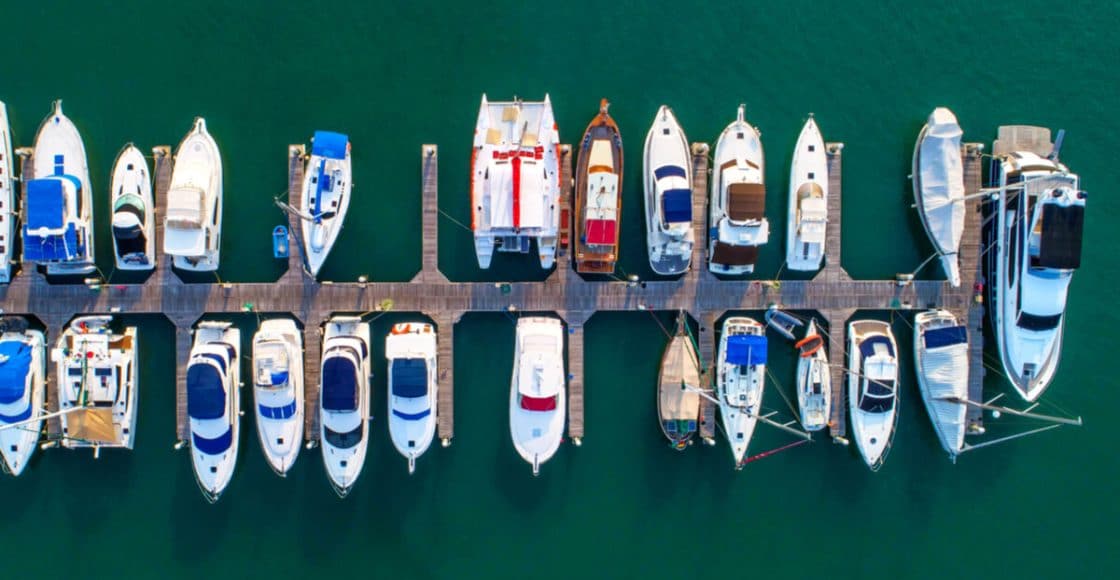
Yachts vs. Boats: What are the Differences?

Table of Contents
Many people use the words “boat” and “yacht” interchangeably, and some lean on the latter to make their ride sound more impressive. But what are the key differences between boats and yachts?
First, let’s look at some broad definitions of a boat, a yacht, and other related vessels.
- “Boat” can refer to just about any kind of vessel— towboat , fishing boat , center console , houseboat , and so on.
- “Dinghy” designates a small boat with a human or wind means of propulsion including a rowing dinghy or sailing dinghy. It also refers to a tender to a bigger boat or yacht.
- “Ship” is a large commercial boat, often used for distance travel and transport of goods or passengers – cruise ship, container ship, etc.
- “Yacht” is typically a larger boat with luxury amenities used as a recreational vessel— motor yacht , sailing yacht .
- “Superyacht” is a large yacht and is often also called a mega yacht . The delineation used to be at 80-feet but again, with today’s size creep, anything under 100 feet would just simply be called a yacht.
So, yacht or boat? Let’s dive deeper into the elements that differentiate a boat from a yacht.
Own a Boat or a Yacht? Learn How to Offset the Cost of Ownership by Listing on Boatsetter
Size of the Vessel
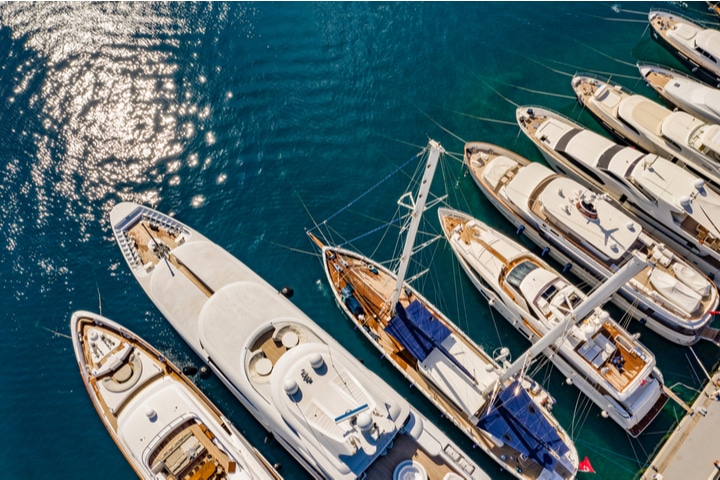
Some place a hard line at 35 feet. Below that, you have a boat and above, it’s a yacht. However, that’s an artificial differentiator.
Just 30 years ago, a 30-foot boat was considered large and could have been a yacht but as recreational boats grow longer, the term yacht has been pushed up the scale.
That said, a well-kept 40-foot boat designed for recreation can technically still be called a yacht (although larger vessels are likely to cost more, price isn’t a good indicator of yacht status primarily because it fluctuates with brand, age, and amenities).
Check out local yacht rentals near you to understand how size plays a difference.
What it’s Used For
A yacht is a vessel designed for recreational purposes. It generally operates on open waters (rather than small lakes or rivers) and has accommodations for overnight guests.
A cruise ship, on the other hand, accommodates a large number of passengers in a commercial setting whereas a yacht carries a smaller number (of paying or non-paying) passengers for private recreation.
Onboard Technology
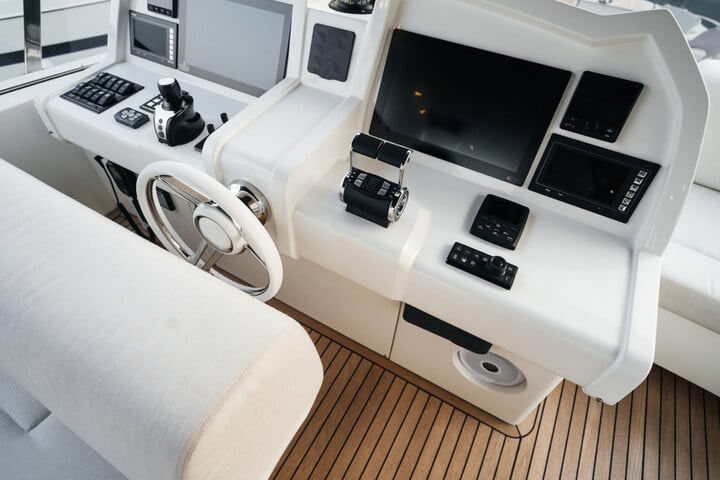
Advanced technology for navigation, communications, and system operation as well as redundant systems for safety can be found on a yacht that is likely to venture farther.
Again, there are caveats because today’s towboats that are fun day boats also feature technology such as GPS and digital switching that integrates many electrical and electronic features.
Propulsion Types
This is a tricky one. “Yacht” comes from the Dutch word “jaght” which referred to a sailing vessel that was used by the navy to capture pirate ships and later for recreation by the affluent.
Today, a yacht can be a large sailing vessel or a motor yacht. All larger yachts will have a motor for propulsion whether they have sails or not. Sailboats by design have smaller motors so trying to put a horsepower minimum on yacht propulsion is simply inaccurate.
Some define a yacht as having multiple crews to operate the vessel and tend to passengers or guests. The larger the yacht, the more crew will be required to navigate, maintain and service the vessel. That said, a couple who owns a 50-footer can call their boat a yacht although it’s owner-operated.
Luxury and Amenities
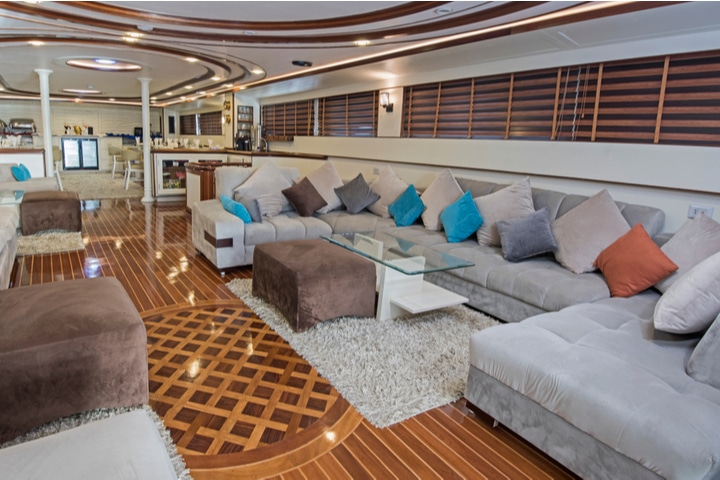
This is perhaps the best measure of a yacht. If the vessel offers accommodations, a galley , a head , and is luxurious in its presentation, it’s most likely a yacht.
That said, there are lots of center console fishing boats and towboats that are pretty nicely equipped these days and they wouldn’t be called a yacht.
All yachts are boats, but not all boats are yachts—and the lines are blurry. The word yacht elicits images of posh seafaring experiences while a boat evokes ideas of fun and perhaps work. Do some research to learn what size and type of boat or yacht is best for you .
To a degree, the point at which a boat becomes a yacht is in the ear of the beholder but if you focus on size, amenities, and the type of use, you’ll be able to discern the difference. Then all that remains is to find a way to spend time and have fun on any kind of vessel.
Browse All Available Boat & Yacht Rentals Across the Globe

Zuzana Prochazka is an award-winning freelance journalist and photographer with regular contributions to more than a dozen sailing and powerboating magazines and online publications including Southern Boating, SEA, Latitudes & Attitudes and SAIL. She is SAIL magazines Charter Editor and the Executive Director of Boating Writers International. Zuzana serves as judge for SAIL’s Best Boats awards and for Europe’s Best of Boats in Berlin.
A USCG 100 Ton Master, Zuzana founded and manages a flotilla charter organization called Zescapes that takes guests adventure sailing at destinations worldwide.
Zuzana has lived in Europe, Africa and the United States and has traveled extensively in South America, the islands of the South Pacific and Mexico.
Browse by experience

Explore articles

9 Best Lakes in Dallas to Swim

Lake Norman Boating Guide: Everything You Need to Know
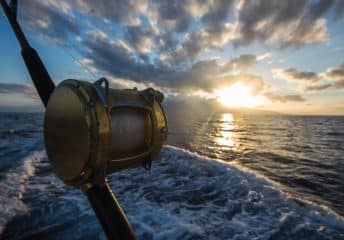
Honolulu, Hawaii Fishing Guide
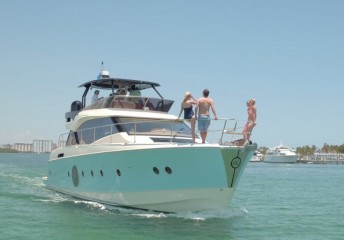
A Beginner’s Guide to Bareboat Yacht Charters

8 Differences Between Yachting and Sailing

Last Updated by
Daniel Wade
June 15, 2022
Unless you are very involved in the sailing community or own a boat of your own, you may think of yachting and sailing as similar.
In a lot of ways they are, after all, both are boats and both spend their time at sea. But, that’s about the end of the direct comparison.
Sailboats and yachts are very different, each with their pros and cons. Whether you are just curious about what the differences are, or are wondering because you plan to buy a boat yourself you’re in the right place. This article lists 8 distinct differences between yachting and sailing.
Hopefully, by the end of this article, you will have a much better idea about which might be better for you. After all, yachting/sailing isn’t for everyone.
Table of contents
One of the biggest differences between a yacht and a sailboat is its size. A sailboat is likely to be much smaller than a yacht. Of course, some sailboats can be bigger than some yachts but if we are working on average sizes a yacht is going to be bigger. The reason that size matters so much when it comes to picking which boat you are going to purchase (sailboat or yacht) is space. The bigger your boat, the more space you are going to have. This may sound obvious but is one of the most important factors about your boat that people often fail to give their full consideration.
Size matters (when it comes to boats). Don’t let anyone tell you otherwise. The size of your boat will factor into almost every single thing you do, every day. The smaller your boat the less room you have for storage, the less room you have for emergency supplies, the less room you have for storing even yourself. Your sleeping quarters are not likely going to be very big, regardless of how big your boat is. Depending on how tall you are every inch of space could matter. If you are 6 feet tall and your sleeping quarters are only just big enough, or worse, too small. You are in trouble. It may not immediately bother you. You may even be able to trick yourself into thinking that you are fine curled up into a ball whenever you are trying to sleep. You won’t feel this way for long.
Size matters most when there are more people on your boat than just yourself. If you are planning on living on your boat solo you have a huge advantage space-wise. Whether you have 1 person or multiple you will still need the same kit. A watermaker , water storage, food storage, a first aid kit, a fishing rod, etc. You won’t need 3 first aid kits if you have 3 people on board. All of this means the biggest difference between living solo and living with others is the sleeping room. If you are living solo on a boat that can in theory sleep 4, congrats, you now have a whole lot more storage.
Conversely, if you are planning on living on your boat with someone (perhaps your spouse) then space matters even more. Two people need to be able to move about comfortably. Just because your little sailboat can sleep two doesn’t mean two people will be able to live on it comfortably. If there is more than one of you, you may be better off with a yacht.
For the most part, the yachts are going to be more expensive. Sometimes a whole lot more. For a few reasons, mostly material and technology. The more modern a boat is the more expensive it is likely to be. This isn’t always the case, it is for the majority of the time though. If the price is going to play a big part in which boat you choose to buy here is something you may want to consider; just because a yacht can cost more doesn’t mean you shouldn’t get one. If you are on the fence, it is almost always to spend the extra money on something bigger and better.
When you buy a house, it is not uncommon to buy one to fix it up. Making little repairs and upgrades here and there, in some cases even building an extension. This doesn’t work with boats. The boat you buy is the boat you get. Sure, it can be improved. Repainted, renovated, modernized, but for the most part, it will stay the same size. You need to treat buying the boat the same as you would buying a car in this way. You wouldn’t buy a small hatchback and then build another story on it. The size boat you buy is the size boat you are stuck with. If you need more room, you will need another boat. It will work out much cheaper in the long run if you buy one expensive boat than having to buy a second slightly cheaper one because the first wasn’t up to scratch.
How much the crew will factor into your choice largely depends on budget and the size of the vessel you have your eye on. If you are planning on buying a sailboat, you aren’t going to need (or want) any kind of crew. You are the whole crew, except maybe your family/friends if they happen to live on your boat with you. If you have a yacht, however, its a completely different story. If you are planning on living aboard your yacht you may need one or two crew members to help you out. Even if you are fulfilling the most important role (captain), there will still be lots to do. Navigation, maintenance, and engineering may not be your forte.
If you are planning on buying a sailboat, you can handle everything yourself. There are relatively few computer components that will need working on and chances are you won’t have an engine. Repairs to a sailboat are not easy per se, they are just more manageable for one person. Changing a sail is much easier than repairing an engine. In severe conditions, a small sailboat is simply easier to keep an eye on than a huge yacht. A yacht may require, at the very least, another pair of eyes.
4. Whether or not there is a sail
This difference is purely aesthetic for the most part. Whether or not there is a sail. A sailboat, unsurprisingly, will always have a sail. The nail is how the boat harnesses the wind and what drives it forward. Sailing can be done anywhere, anytime, so long as the weather permits it. Yachting, on the other hand, can be far more limiting. A yacht typically won’t have a sail, which can be seen as either a positive or a negative depending on your outlook. Heres why.
If you are looking for a vessel that is easier to handle, you could argue that a yacht would fit those criteria better. Sure, the computer components are a little more complex and there is more to handle, but sailing itself will be easier. If you have to manage a sail, it can be pretty difficult in stormy conditions. You cant control your sails from inside the cabin. You can, however, steer your yacht from the comfort of the inside.
The advantage of having a sail, as opposed to just an engine, is that you don’t need to worry about fuel. Fuel is not only expensive but a real hassle. You must always keep an eye on your fuel levels when making long voyages or else you risk breaking down at sea. A sailboat can sail so long as there is wind. If you have an extra sail onboard, chances are you will be fine no matter what happens. You are much less likely to get stuck at sea.
5. Engine size
Some sailboats do have motors, albeit small ones. It could just be a trolling motor or as big as a 2 stroke. Regardless of what engine size you have, it is never going to be your primary power source. If you have sails you get your power from harnassing the wind. This, again, can be seen as either good or bad. If you have a small engine you have less to worry about. If you only have the most basic mechanical skills and knowhow you will probably be fine.
A yacht, on the other hand, is a whole different beast. If you don’t know how to work on your yacht in the engine room and you break down you are in real trouble. Owning a yacht can be far more complex than owning a sailboat in this regard. If you don’t anticipate learning how to make these repairs yourself, you are going to need to hire someone who will. Its no good just relying on the marina workshop or a local mechanic, if you are at sea there will be no way for them to get to you. Hiring a crew member with good mechanical abilities isn’t going to be cheap. It is a recurring cost you may want to factor into your budget when deciding whether or not a yacht is right for you.
6. Where they can sail
Big yachts cannot sail in shallow waters. If you are planning on sailing in places with shallow, shale filled, waters then a sailboat is the way to go. The Caribbean, for example, can be hard to navigate in a yacht. At least, harder than it would be with a sailing boat. On the other hand, a yacht can go to many more places than a sailboat.
You could, in theory, sail across the Atlantic in a small sailboat . But, would you want to? It is very dangerous and your boat might not hold up to the intense wind and waves. Additionally, if you are on a sailboat you might be the only crew member. This means there will be no one around to help you should the worst come to fruition, far out at sea. It can be done, you can sail across the Atlantic. But you probably shouldn’t.
7. Technology
In regards to technology, not just whether you are choosing a sailboat or a yacht must be given consideration. How old the individual vessel is, is equally important. An older yacht may not be as technologically advanced as a brand new sailboat . If you do choose to buy a yacht, better technology can open a lot of doors for you. First of all, it can make working on your boat a lot easier. If you have the capability of setting up a fully functioning office with wifi there is no reason you couldn’t just work remotely from your boat.
Technology also opens many new routes for you to take regarding the act of sailing itself. You could sail across the Atlantic with a sailboat, but it would be very risky and very difficult. With a yacht, on the other hand, it can be far easier. Your yacht will come equipped with advanced navigational systems, warning and guidance systems, and much more safety features than a sailboat would. A yacht will be able to plot your route from point to point. On a sailboat, you may not have that luxury.
8. Material
Material matters, whether it is affecting the cost or the sturdiness, it is something to consider. A yacht will be made of fiberglass, carbon fiber, and metals such as titanium. A sailboat, on the other hand, will likely be made from wood or fiberglass. If you are looking for safety and sturdiness above all, and the price is no problem, a yacht will be far safer for you. On the other hand, a sailboat might have the aesthetic you are looking for. You may want a wooden sailboat specifically because you think it looks better.
The material can also factor into how easy it is for you to make repairs. It is a lot easier to patch up a wooden boat than a metal one. With wood, you can make some cowboy fixes on the fly and they will likely hold up until you make it to port. With a yacht, you will need many special tools and training to make big repairs. Again, you may need to hire a crew member to handle that for you on a yacht.
Hopefully, you now have a pretty good idea about the differences between yachts and sailboats. They each have their pros and cons, and can both offer you a world of excitement and adventure. Which boat would be best for you depends solely on your needs. There is no right or wrong answer when it comes to which boat to choose, just go with your gut instinct. Hopefully, this article has made the decision a little easier. At the very least.
Related Articles
I've personally had thousands of questions about sailing and sailboats over the years. As I learn and experience sailing, and the community, I share the answers that work and make sense to me, here on Life of Sailing.
by this author
Learn About Sailboats
Most Recent

What Does "Sailing By The Lee" Mean?
October 3, 2023

The Best Sailing Schools And Programs: Reviews & Ratings
September 26, 2023
Important Legal Info
Lifeofsailing.com is a participant in the Amazon Services LLC Associates Program, an affiliate advertising program designed to provide a means for sites to earn advertising fees by advertising and linking to Amazon. This site also participates in other affiliate programs and is compensated for referring traffic and business to these companies.
Similar Posts

Affordable Sailboats You Can Build at Home
September 13, 2023

Best Small Sailboat Ornaments
September 12, 2023

Discover the Magic of Hydrofoil Sailboats
December 11, 2023
Popular Posts

Best Liveaboard Catamaran Sailboats
December 28, 2023

Can a Novice Sail Around the World?
Elizabeth O'Malley

4 Best Electric Outboard Motors

How Long Did It Take The Vikings To Sail To England?

10 Best Sailboat Brands (And Why)
December 20, 2023

7 Best Places To Liveaboard A Sailboat
Get the best sailing content.
Top Rated Posts
Lifeofsailing.com is a participant in the Amazon Services LLC Associates Program, an affiliate advertising program designed to provide a means for sites to earn advertising fees by advertising and linking to Amazon. This site also participates in other affiliate programs and is compensated for referring traffic and business to these companies. (866) 342-SAIL
© 2024 Life of Sailing Email: [email protected] Address: 11816 Inwood Rd #3024 Dallas, TX 75244 Disclaimer Privacy Policy
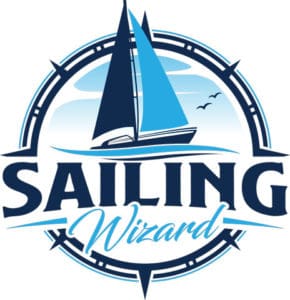
What’s the Difference Between a Boat, Yacht & Ship?
Whether you are a brand new sailor or just wanting to brush up on some terms, it is essential to know what to call a particular watercraft if you’re going to fit in while you’re at the docks or out on the water. There are many nuances and subtle differences between water vessel types, but below are some of the main differences.
In general, yachts are either sailing or motor vessels used for pleasure. Yachts are often luxurious and equipped with an overnight cabin. Boats can be either propelled sail or a motor and come in varying sizes. On the other hand, ships are usually motor-powered and much larger than boats.
Some of the differences between watercraft types can be a little fuzzy, but once you grasp the main differences between them, it becomes relatively easy to tell them apart. If you have no previous knowledge of watercraft, you are likely very confused about what defines a yacht, boat, and ship, so I’ll try to clarify any confusion you might have in the next few sections.
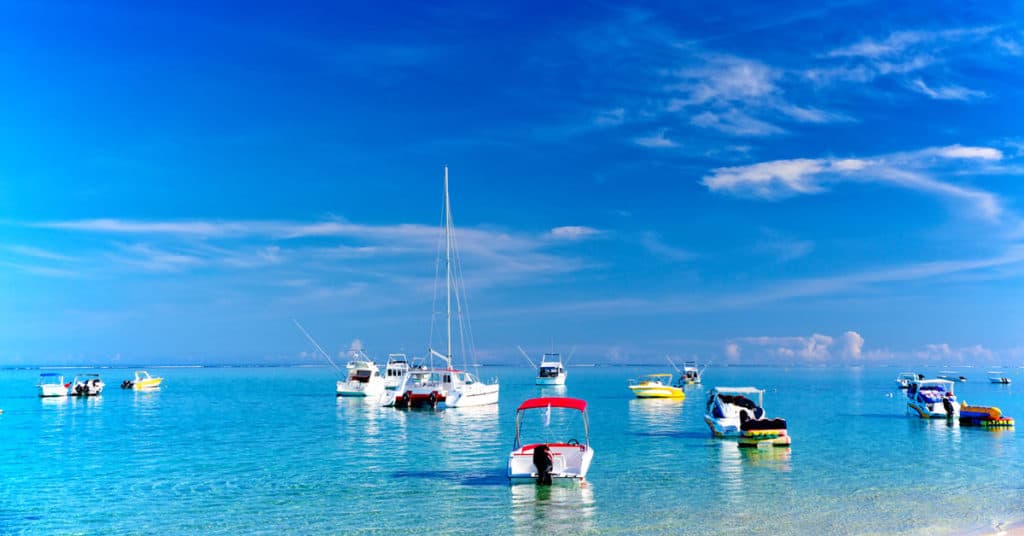
Similarities and Differences Between Boats, Yachts, and Ships
The many bodies of water all over the world are home to an extensive collection of different watercraft. There are so many shapes and sizes that they come in that it is nearly impossible to fit every single one into a specific classification.
However, in the following table, I did my best to loosely define ships, yachts, and boats so that it is easy to see the differences between the types of watercraft.
As I mentioned earlier, it is impossible to fit EVERY SINGLE water vessel into a particular category, so there are tons of exceptions out there. In addition to the exceptions, different organizations, laws, and people classify types of boats slightly differently.
There is no universally accepted definition for ships, boats, and yachts, but instead many different sets of rules and regulations. In this article, I have tried my best to use the most commonly accepted definitions for each watercraft type.
Now that we’ve gone over some of the main differences and similarities between boats, ships, and yachts, let’s take a look at each type of vessel individually and look at their most prominent characteristics and attributes.
What Exactly is a Boat?
Boats come in a vast array of sizes and shapes. To many people, the term “boat” simply refers to nearly any watercraft, but there are actually a few restrictions and defining characteristics that all boats have. So let’s just get right into it and take a quick look at what exactly qualifies a vessel as a boat.

Overall Size of Boats
As I said before, there is a massive catalog of different types of boats, and they come in a variety of sizes. There are huge boats that hold lots of cargo or people, and then there are smaller ones that barely can stay afloat with a single person on board.
Typically, boats are defined as watercraft that are less than 197 feet long. However, most boats you are likely to encounter on the water are usually around 30 feet long.
General Price Range of Boats
Again, it is hard to accurately give a price range for all boats because they come in so many different sizes, styles, and types, but most modern boats seem to fall in the $1,500 to $100,000 range.
Small Jon boats can cost even less than $1,500, while large sailboats and houseboats can cost well above $100,000.
Most Common Uses of Boats
Boats are used all over the world for a variety of different reasons and to do many tasks. Many types of boats serve a wide range of uses, but most are primarily used as a residence, for pleasure, or commercially.
Some of the most popular types of boats, such as sailboats, bowriders, and dinghies, are commonly used for enjoyment, fishing, racing, or other pleasurable activities. There are also many types of houseboats used as residences and commercial boats used for chartering or moving goods or people.
Propulsion Method of Boats
Due to the wide variety of boats, you are likely to find boats propelled by almost every propulsion method imaginable. Some of the more popular propulsion methods for boats to use are man-power, wind power, and motor power.
Boats on the smaller end often use the power of the people on board to row or paddle, while larger boats rely on sails or powerful motors attached to the stern. Many boats use more than one propulsion method, either together or with one of them as a backup.
What Exactly is a Yacht?
Yachts have many of the same attributes as boats, but their quality, size, and luxury really set them apart. When someone says “yacht,” many people imagine watercraft that are SUPER LARGE, and while there are lots of massive yachts, many smaller boats also qualify as yachts, which might surprise you.
Overall Size of Yachts
There are many different sized yachts, and the rules regarding how big they have to be are not very strict. In general, luxury watercraft greater than 33 feet in length are considered yachts. However, boats smaller than 33 feet are sometimes called yachts if they are exceptionally luxurious and elegant.
There is no upper limit to how large a yacht can be. Yachts longer than 100 feet are often referred to as mega yachts, and ones over 150 feet long called are super yachts.
General Price Range of Yachts
Because the very definition of a yacht requires it to be very luxurious, they often come with quite a price tag as a result. There is quite a range of different price points for yachts, ranging from $250,000 to $50,000,000 and beyond.
Most Common Uses of Yachts
Yachts, because they are so expensive to maintain and purchase, are primarily used for pleasure purposes. Day trips out on the water are typical for yachts, although they often have overnight cabins, so longer excursions are popular.
Chartered yachts are also very popular, which bridges the gap between commercial and pleasure. Although, when you are on a chartered yacht, it is usually for the sole purpose of having a great time and enjoying yourself.
Propulsion Method of Yachts
Because yachts are considered very luxurious and often so large, they are usually solely propelling using motor power. Even if a yacht is on the smaller end of the spectrum, they often only use a motor as a means of driving the craft through the water.
However, many large sailing yachts out there use sails and the wind to propel the vessel. So while the large majority of yachts use motors, keep in mind that some large and luxurious sailboats can be considered yachts.
What Exactly is a Ship?
Throughout history, large ships have been a helpful tool for many civilizations and have allowed them to transport goods and explore places beyond their homes. In modern times, ships are quite common and are used for a variety of different reasons.
Overall Size of Ships
One of the primary characteristics of ships that set them apart from boats is their size. Ships, especially in modern times, are often MASSIVE and are restricted to navigating only extensive waterways.
Vessels greater than or equal to 197 feet long are often considered ships. However, most ships today are huge and often fall in the 1,000-foot range or larger.
General Price Range of Ships
Most individuals will never own a ship due to their extreme maintenance and the cost of purchasing one. While many smaller ships are far less expensive, most modern ships cost anywhere between $50 and $500 million.
Large and luxurious cruise ships can even cost upwards of $1 billion to construct, and that’s not even taking into account staff, maintenance, and other costs.
Most Common Uses of Ships
Ships perform many different duties throughout the world, but usually, they are used to transport passengers or goods over long distances. In addition, they are also often used by military, scientists, fishers, and a plethora of other professions and people. They are also often used for pleasure purposes, in the form of passenger cruise ships.
Overall, ships encompass a large selection of vessels that perform many different duties.
Propulsion Method of Ships
Due to their large size, most modern ships are propelled using motors. However, even though ships are equipped with massive motors, they are still pretty slow and often move at around 20 knots per hour, although some move much quicker.
While most, if not all, ships today use motors to propel themselves through the water, this was not always the case. Before motors were around, many civilizations used ships for military, exploration, transportation, shipping, and many other uses. During these times, ships were powered primarily by man and wind power. Even today, you can occasionally find a sail-powered ship, though they are quite rare.
James Gerard
Hi, I'm James! I started sailing at a very early age here in the UK, and have enjoyed so many opportunities to sail all over the world. I created this website to share the many sailing tips I've leaned over the years, so that you can also discover the joy of sailing with safety and confidence.
Recent Posts
How to Predict Wind Direction & Speed from a Surface Pressure Chart
Learning how to read a surface pressure chart will allow you to predict the wind speed and direction based on the weather chart. This will help you in planning your next sailing trip.
What Does a Black & Yellow Buoy Mean? (Cardinal Marks Explained)
If you see a black and yellow buoy while you're sailing, don't ignore it. Cardinal Marks are there to help you avoid hidden hazards in the water. This helpful article will help you to identify a...

Types of Sailing Yachts: Pros, Cons and Comparison

There are many different types of sailing yachts, each with their own unique features and characteristics. Here, we will discuss some of the most popular types of sailing yachts and the features that set them apart.
Table of Contents
Cruiser/Racer

Cruiser/Racer sailing yachts are designed for both cruising and racing, making them versatile and popular among sailors of all skill levels. These yachts typically have a comfortable interior for longer trips and a more performance-oriented hull design for racing.
One of the key features of cruiser/racer yachts is their balance between comfort and performance. While they have the amenities and space needed for cruising, such as a comfortable interior, a large cockpit, and a variety of amenities for extended voyages, they also have a more performance-oriented hull design for racing. This allows sailors to enjoy the best of both worlds, whether they want to go for a leisurely cruise or participate in a racing event.
The hull design of cruiser/racer yachts is typically more hydrodynamic than traditional cruising yachts, which allows for better speed and manoeuvrability. Additionally, these yachts often have a more lightweight construction to help reduce drag and increase performance.
Another feature that sets cruiser/racer yachts apart is their modern sail plan. They are often equipped with larger and more powerful sails than traditional cruising yachts, which allows them to reach higher speeds and perform better in racing conditions.
Cruiser/Racer sailing yachts are popular among sailors who want to participate in racing events, but also want to take longer trips and enjoy the comfort and amenities of a cruising yacht. They are also popular among sailors who want to learn to race, but don’t want to sacrifice the comfort and space of a traditional cruising yacht.
Pros and Cons of Cruiser/Racer
Cruiser/Racer yachts are versatile sailing yachts that are designed for both cruising and racing, making them popular among sailors of all skill levels. However, like any type of yacht, they have their own set of pros and cons.
- Versatility: Cruiser/Racer yachts are designed for both cruising and racing, which makes them a great choice for sailors who want to do both. They have a comfortable interior for longer trips and a more performance-oriented hull design for racing, which allows sailors to enjoy the best of both worlds.
- Balance of comfort and performance: Cruiser/Racer yachts are designed to provide a balance of comfort and performance. They have the amenities and space needed for cruising, but also have a more performance-oriented hull design for racing, which allows them to perform well in racing conditions.
- Good for learning to race: Cruiser/Racer yachts are a great choice for sailors who want to learn to race, but don’t want to sacrifice the comfort and space of a traditional cruising yacht.
- Expensive: Cruiser/Racer yachts can be more expensive than other types of yachts, especially if they are designed and built to high specifications.
- Maintenance: Cruiser/Racer yachts require more maintenance than other types of yachts, as they have more complex systems and features.
- Not as comfortable as a cruiser: Cruiser/Racer yachts are not as comfortable as traditional cruising yachts, as they have more performance
Overall, Cruiser/Racer sailing yachts are a great choice for sailors looking for a versatile yacht that can handle both cruising and racing. With their comfortable interior, performance-oriented hull design, and modern sail plan, these yachts offer the perfect balance between comfort and performance.

Daysailer sailing yachts, as the name suggests, are designed for short trips and day sails. They are typically smaller and more compact than other types of yachts, and are often used for training or recreational sailing.
One of the key features of daysailers is their small size and simplicity. They typically have a smaller cockpit, a simple sailplan, and minimal amenities, which makes them easy to handle and maneuver for sailors of all skill levels. This makes them ideal for training, learning to sail, or for short trips where you don’t need to bring much gear or supplies.
Daysailers also typically have a more lightweight construction than other types of sailing yachts, which allows them to be more responsive and maneuverable on the water. This makes them ideal for racing and other competitive sailing events.
Another feature that sets daysailers apart is their affordability. They are often less expensive than other types of yachts, which makes them an accessible option for sailors who are just starting out or who are on a budget.
Daysailers are also popular among sailors who prefer the simplicity of day sailing and are not interested in overnight trips or longer cruises. They are also a great choice for sailors who want to enjoy the experience of sailing without the added responsibilities that come with owning a larger yacht.
Pros and Cons of Daysailers
Daysailer yachts are designed for short trips and day sails, and are typically smaller and more compact than other types of yachts. They are often used for training or recreational sailing. However, like any type of yacht, they have their own set of pros and cons.
- Affordable: Daysailers are often less expensive than other types of yachts, which makes them an accessible option for sailors who are just starting out or who are on a budget.
- Easy to handle: Daysailers typically have a small cockpit, a simple sail plan, and minimal amenities, which makes them easy to handle and maneuver for sailors of all skill levels. This makes them ideal for training, learning to sail, or for short trips where you don’t need to bring much gear or supplies.
- Lightweight construction: Daysailers have a more lightweight construction than other types of sailing yachts, which allows them to be more responsive and maneuverable on the water. This makes them ideal for racing and other competitive sailing events.
- Limited amenities: Daysailers have limited amenities, which means they are not designed for overnight stays or longer cruises.
- Limited space: Daysailers typically have limited space, which makes them less comfortable than larger yachts.
- Not suitable for long-distance cruising: Daysailers are not suitable for long-distance cruising or live-aboard cruising as they are not equipped for it.
Overall, Daysailer yachts are a great choice for sailors looking for a small, easy-to-handle, and affordable yacht that is ideal for day sailing and short trips. However, they are not suitable for overnight trips or long-distance cruising, and have limited amenities and space.
Racing Yacht

Racing yachts are designed specifically for speed and performance. They are typically much smaller than cruising yachts, and are built to be as lightweight and hydrodynamic as possible. They are often used in competitive sailing events, such as regattas and races.
One of the key features of racing yachts is their lightweight construction. They are typically made of materials such as carbon fiber or high-tech composites, which are both lightweight and strong. This allows them to reach high speeds and perform well in racing conditions.
Another feature that sets racing yachts apart is their hydrodynamic hull design. These yachts are built with a sharp bow, a narrow beam and a long waterline, which helps them to cut through the water more efficiently and reach higher speeds. They also tend to have a deep keel, which provides them with more stability and helps them to perform better in strong winds and rough seas.
Racing yachts also often have a more modern sail plan, with larger and more powerful sails that allow them to reach higher speeds and perform better in racing conditions. They also often have a smaller interior to keep weight down, which can make them less comfortable for overnight stays.
Racing yachts are popular among sailors who want to participate in competitive sailing events and races. They are also popular among sailors who want to experience the thrill of sailing at high speeds and pushing the limits of performance. However, it’s important to keep in mind that racing yachts are not as comfortable for long cruises as other types of sailing yachts and they can be expensive to maintain.
Pros and Cons of Racing yachts
Racing yachts are designed specifically for speed and performance, and are often used in competitive sailing events such as regattas and races. However, like any type of yacht, they have their own set of pros and cons.
- Speed: Racing yachts are built with lightweight construction and a hydrodynamic hull design, which allows them to reach high speeds and perform well in racing conditions.
- Maneuverability : Racing yachts are designed to be highly maneuverable, which allows them to perform well in tight and technical racing conditions.
- Modern sail plan : Racing yachts are often equipped with larger and more powerful sails than traditional cruising yachts, which allows them to reach higher speeds and perform better in racing conditions.
- Cost : Racing yachts can be expensive to purchase and maintain, especially if they are designed and built to high specifications.
- Comfort : Racing yachts typically have a smaller interior than other yachts, which can make them less comfortable for overnight stays.
- Maintenance : Racing yachts require more maintenance than other types of yachts, as they have more complex systems and features, and they are often pushed to the limits of their performance.
- Not suitable for long-distance cruising : Racing yachts are not suitable for long-distance cruising or live-aboard cruising as they are not equipped for it.
Overall, Racing yachts are a great choice for sailors looking for a high-performance sailing vessel that can be used in competitive sailing events. With their lightweight construction, hydrodynamic hull design, and modern sail plan, racing yachts are designed to reach high speeds and perform well in racing conditions. However, they can be expensive to purchase and maintain, and may not be as comfortable as other types of yachts for overnight stays or long-distance cruising.

Cruising yachts, also known as cruisers, are designed for longer trips and are typically larger and more comfortable than other types of yachts. They are built for extended voyages, and often have a spacious interior, a large cockpit, and a variety of amenities to make life on board more comfortable.
One of the key features of cruising yachts is their spacious interior. They are designed to have multiple cabins, a large salon, and a well-appointed galley, which makes them ideal for longer trips and live-aboard cruising. They also usually have a lot of storage space, so you can bring all the gear and supplies you’ll need for an extended voyage.
Another feature that sets cruising yachts apart is their stability and seaworthiness. They are designed to handle rough seas and strong winds, which allows them to be more comfortable and safer for longer trips. They also typically have a more comfortable motion, which helps to reduce fatigue for those on board.
Cruising yachts also often have a variety of amenities, such as air conditioning, generators, and refrigeration, which make them more comfortable and convenient for longer trips. They also often have a larger cockpit, which provides more space for relaxing and entertaining.
Cruising yachts are popular among sailors who want to take longer trips, live aboard or even cross oceans. They are also popular among sailors who want to experience the comfort and convenience of a well-appointed yacht. However, it’s worth noting that cruising yachts are typically more expensive than other types of yachts and they require more maintenance.
Overall, cruising yachts are a great choice for sailors looking for a comfortable and seaworthy yacht that can handle longer trips and live-aboard cruising. With their spacious interior, stability, and variety of amenities, cruising yachts are designed to make life on board as comfortable and convenient as possible.

A catamaran is a type of sailing yacht that has two parallel hulls, rather than one. They are known for their stability and spaciousness, making them popular for longer trips, live-aboard cruising, and charter vacations.
One of the key features of catamarans is their stability. With two hulls, the boat has a lower center of gravity and a wider beam, which makes them less likely to tip over in rough seas. This makes them a comfortable and safe option for longer trips and live-aboard cruising.
Another feature that sets catamarans apart is their spaciousness. They typically have a larger interior than monohulls of the same length, which allows for more living and storage space. This makes them ideal for bigger groups of people or for longer trips. They also usually have a larger cockpit, which provides more space for relaxing and entertaining.
Catamarans also often have a more shallow draft than monohulls, which allows them to navigate shallow waters, and anchor in more secluded bays. This can open up new opportunities for cruising, especially in areas where monohulls can’t access.
Catamarans are popular among sailors who want to take longer trips, live aboard, or who are looking for more stability and spaciousness. They are also popular among sailors who want to experience the comfort and convenience of a well-appointed yacht. However, it’s worth noting that catamarans are typically more expensive than other types of yachts and they require more maintenance.
Pros and cons of Catamaran
Catamarans are a type of sailing yacht that have two parallel hulls, which makes them known for their stability and spaciousness. They are popular for longer trips, live-aboard cruising, and charter vacations. However, like any type of yacht, they have their own set of pros and cons.
- Stability: Catamarans have a lower center of gravity and a wider beam than monohulls which make them less likely to tip over in rough seas. This makes them a comfortable and safe option for longer trips and live-aboard cruising.
- Space: Catamarans typically have a larger interior than monohulls of the same length, which allows for more living and storage space. This makes them ideal for bigger groups of people or for longer trips.
- Shallow draft: Catamarans also often have a more shallow draft than monohulls, which allows them to navigate shallow waters and anchor in more secluded bays.
- Cost: Catamarans can be more expensive than other types of yachts, especially if they are designed and built to high specifications.
- Maintenance: Catamarans require more maintenance than other types of yachts, as they have more complex systems and features.
- Not suitable for racing: Catamarans are not typically used for racing as they are not as fast as monohulls.
- Can be affected by wind direction: Catamarans can be affected by the wind direction, as the wind can hit the hulls from the side and can cause them to heel over.
Overall, Catamarans are a great choice for sailors looking for a stable and spacious yacht that can handle longer trips and live-aboard cruising. With their stability, spaciousness, and shallow draft, Catamarans are designed to provide a comfortable and safe sailing experience. However, they can be expensive and require more maintenance, they are

A trimaran is a type of sailing yacht that has three hulls, two smaller amas (outrigger hulls) and a central main hull, rather than one. They are known for their speed and stability, and are often used for racing and long-distance cruising.
One of the key features of trimarans is their speed. The two smaller amas, which are located on the sides of the main hull, increase the waterline length and provide more surface area for the sails to push against. This allows them to reach higher speeds and perform better in racing conditions.
Another feature that sets trimarans apart is their stability. With three hulls, the boat has a lower center of gravity and a wider beam, which makes them less likely to tip over in rough seas. This makes them a comfortable and safe option for longer trips and live-aboard cruising.
Trimarans also often have a more shallow draft than monohulls, which allows them to navigate shallow waters, and anchor in more secluded bays. This can open up new opportunities for cruising, especially in areas where monohulls can’t access.
Trimarans are popular among sailors who want to participate in racing events, and also want to take longer trips and enjoy the comfort and amenities of a cruising yacht. They are also popular among sailors who want to experience the thrill of sailing at high speeds and pushing the limits of performance. However, it’s worth noting that trimarans can be expensive to maintain and they also need more space to store.
Overall, trimarans are a great choice for sailors looking for a high-performance sailing vessel that can handle both racing and long-distance cruising. With their speed, stability, and shallow draft, trimarans are designed to provide a comfortable and safe sailing experience while reaching high speeds and performing well in racing conditions.
Pros and Cons of Trimaran
Trimarans have several advantages over monohull boats:
- Faster: Trimarans have a wider beam (the width of the boat) than monohulls, which gives them more stability and allows them to sail faster.
- Shallower draft: Because the majority of the weight is on the main hull, trimarans have a shallower draft (the depth of the boat in the water) than monohulls, which allows them to navigate in shallower waters.
- More space: Trimarans have more space on deck and inside the boat, which makes them more comfortable for longer trips.
- Less comfortable in rough seas: Trimarans can be less comfortable in rough seas because the smaller hulls can be affected by the waves.
- More difficult to handle: Trimarans can be more difficult to handle than monohulls because they have a larger sail area and a wider beam.
- More expensive: Trimarans are generally more expensive to build and maintain than monohulls.
In summary, Trimarans are faster, more stable, and have more space, but they can be less comfortable in rough seas and are more difficult to handle. They are also more expensive than monohulls.
Classic Yacht

A classic yacht is a type of sailing yacht that is typically older and has been restored or maintained in its original condition. These yachts often have a timeless aesthetic and are often made of wood, they are often used for historical sailing events and regattas.
One of the key features of classic yachts is their unique and timeless design. They often have a traditional and elegant aesthetic, with classic lines, and a beautiful woodwork finish. These yachts are often one of a kind, as many of them were custom-built for their original owners.
Another feature that sets classic yachts apart is their history. Many of these yachts have a rich and interesting past, and have often been sailed by famous sailors, or have participated in significant sailing events. This can add to the charm and allure of owning and sailing a classic yacht.
Classic yachts also often have a more traditional sail plan and rigging, which can add to the sailing experience. Sailing a classic yacht can be a unique and rewarding experience, as it allows sailors to connect with the rich history of sailing and to appreciate the craftsmanship of these yachts.
Classic yachts are popular among sailors who appreciate the beauty and craftsmanship of traditional sailing yachts, and who want to experience the unique sailing experience that these yachts offer. They are also popular among sailors who want to participate in historical sailing events and regattas. However, it’s worth noting that classic yachts can be expensive to maintain, and require more expertise and care to keep in good condition.
Pros and Cons of Classic Yacht
Classic yachts are a type of sailing yacht that are typically older and have been restored or maintained in their original condition. They often have a timeless aesthetic and are often made of wood. They are often used for historical sailing events and regattas. However, like any type of yacht, they have their own set of pros and cons.
- Timeless design: Classic yachts often have a traditional and elegant aesthetic, with classic lines and beautiful woodwork finish. These yachts are often one of a kind, as many of them were custom-built for their original owners.
- History: Many classic yachts have a rich and interesting past, and have often been sailed by famous sailors or have participated in significant sailing events. This can add to the charm and allure of owning and sailing a classic yacht.
- Traditional sailing experience: Classic yachts often have a more traditional sail plan and rigging, which can add to the sailing experience. Sailing a classic yacht can be a unique and rewarding experience, as it allows sailors to connect with the rich history of sailing and to appreciate the craftsmanship of these yachts.
- Maintenance: Classic yachts require more maintenance than other types of yachts, as they are often older and may require more repairs and restoration.
- Expensive: Classic yachts can be expensive to purchase, maintain, and restore, especially if they are in high demand or have a rich history.
- Limited amenities: Classic yachts often have limited amenities, which can make them less comfortable than newer yachts. They may not have modern features such as air conditioning, generators, and refrigeration, which can be a drawback for longer trips or live-aboard cruising.
- Limited performance: Classic yachts are not built for speed and performance, as they were not designed for racing and competitive sailing events. They may not perform as well as newer yachts in racing conditions.
- Limited availability: Classic yachts are not as readily available as newer yachts, and it can be difficult to find one that fits your needs and budget.
Overall, classic yachts are a great choice for sailors who appreciate the beauty and craftsmanship of traditional sailing yachts, and want to experience the unique sailing experience that these yachts offer. However, they can be expensive to purchase and maintain, and may not have the same level of amenities and performance as newer yachts. They also require more maintenance and expertise to keep in good condition.
No matter what type of sailing yacht you choose, it is important to consider the features and characteristics that are most important to you, and to choose a yacht that will suit your needs and preferences. Whether you’re a seasoned sailor or a beginner, there is a yacht out there that will fit your needs.
Steven T. Anderson
Steven Taylor Anderson is an experienced sailor and author who writes for sailingbetter.com. He has been sailing for over 20 years across the USA and has taken several courses to improve his skills. He has also navigated throughout the world on various boats and yachts. His passion for sailing and knowledge of the sport shines through in his writing, making him a respected authority on the subject.
Recent Posts
Lagoon vs Leopard Catamaran: Which Sailboat Is Right for You?
Introduction When it comes to cruising on the open waters, catamarans have gained immense popularity for their stability, space, and comfort. Two of the leading catamaran manufacturers, Lagoon and...
How to Determine Sailboat Weight: A Comprehensive Guide
Introduction Sailing is a thrilling and adventurous activity that has captivated humans for centuries. Whether you are a seasoned sailor or a novice looking to set sail for the first time,...
Boat Virtue

Yacht vs Sailboat (6 Basic Differences)
Yacht vs Sailboat, are they different? Although they may appear similar from a distance, there are several important distinctions between yachts and sailboats .
Both sailboats and yachts are types of boats, but they are not the same. While a yacht is a type of sailboat, all sailboats are not yachts. So what’s the difference?
Sailboats tend to be smaller and less expensive than yachts, making them a good option for those who want to spend time on the water without spending a lot of money.
But while they can be fun and affordable, sailboats don’t offer the same level of luxury or amenities that yachts do.
Table of Contents
Yacht vs Sailboat
When it comes to yachts vs sailboats, there are some key differences that you should be aware of. Yachts are typically much larger than sailboats
And come with a variety of amenities and features that make them ideal for luxury cruising. Sailboats, on the other hand, are smaller and more maneuverable, making them better suited for racing or day sailing.
One of the most obvious differences between yachts and sailboats is their size. Yachts can range in size from 30 feet to over 200 feet.
While sailboats are typically much smaller, with most falling between 20 and 40 feet in length. This difference in size means that yachts have much more space for onboard amenities and features.
Such as multiple bedrooms, spacious living areas, and full-sized kitchens. Sailboats, on the other hand, are typically more spartan in their layout and design, with smaller cabins and minimalistic interiors.
One of the most important factors to consider when choosing a yacht or sailboat is the cost. There are a number of factors that can affect the cost of these two types of vessels.
So it is important to carefully consider each one before making a decision. Yachts are generally more expensive than sailboats because they are larger and more luxurious.
They often have features like hot tubs, staterooms, and multiple bedrooms that make them more expensive to purchase and maintain.
Yachts also tend to be faster than sailboats, which can add to the cost. Sailboats are less expensive than yachts because they are smaller and not as luxurious.
Sailboats also tend to be slower than yachts, which can save on fuel costs. However, sailboats require more maintenance than yachts because they have sails that need to be replaced regularly.
The cost of a yacht or sailboat will also depend on the materials it is made from. Yachts are typically made from fiberglass or aluminum , while sailboats are usually made from wood.
Fiberglass yachts are more expensive than aluminum yachts, but they are also more durable. Aluminum yachts are less expensive, but they are not as durable and can be more difficult to repair.
When it comes to yacht vs sailboat crew, there are a few key differences that you should be aware of. First and foremost, yachts are typically crewed by professional sailors.
Who is experienced in handling the vessel and its passengers? Sailboats, on the other hand, are often crewed by amateur sailors who may not have the same level of experience.
This can be a major factor to consider if you’re planning on hiring a sailboat for your next vacation. Another key difference between yacht and sailboat crews is the size of the vessel.
Yachts are typically much larger than sailboats, which means that they require more crew members to operate efficiently.
Sailboats, on the other hand, are typically much smaller and can be operated with a smaller crew. This can be an important consideration if you’re looking to save money on your charter vacation.
Finally, another key difference to consider when it comes to yacht vs sailboat crew is the cost of the vessel. Yachts are typically much more expensive to charter than sailboats.
This means that you’ll need to be prepared to spend a bit more money upfront. Sailboats, on the other hand, are typically much less expensive and can be an excellent option for those on a budget.
Engine Size
When it comes to yacht vs sailboat engine size, there are a few things that you need to take into consideration.
Yacht engines are typically much larger than those found on sailboats. This is because yachts are designed for longer journeys and need extra power to get them through rough waters.
Sailboats, on the other hand, are designed for shorter trips and can get by with a smaller engine. When deciding which is right for you.
It is important to think about how you will be using your boat. If you plan on spending most of your time sailing, then a sailboat is probably the better option.
However, if you want the option to go on longer journeys, then a yacht is the better choice. Another thing to consider is the cost of fuel.
Yacht engines tend to be much more expensive to operate than those on sailboats. This is because they consume a lot more fuel. If you are on a budget, then a sailboat might be the better option for you.
Finally, you need to think about the maintenance required for each type of engine . Yacht engines are much more complicated and require more maintenance than those on sailboats.
If you are not handy with tools, then a sailboat is probably the better option. As you can see, there are a few things to think about when it comes to yacht vs sailboat engine size.
It is important to consider how you will be using your boat and what your budget is before making a decision. With a little bit of thought, you should be able to find the perfect engine size for your needs.
There are many different types of yachts and sailboats, each with its own unique set of features and benefits. When choosing between the two, it’s important to consider your needs and preferences.
Here’s a closer look at the key differences between yacht and sailboat technology:
Yachts typically have more luxurious features and appointments than sailboats.
Yachts are usually powered by engines, while sailboats rely on wind power.
Yachts tend to be larger than sailboats, making them more suitable for longer journeys.
Sailboats are typically less expensive than yachts. Sailboats are powered by wind, making them more environmentally friendly than yachts. Sailboats are usually smaller than yachts, making them more maneuverable and easier to dock.
There are a few key differences between yacht and sailboat construction materials. Sailboats are generally made with lighter-weight materials such as fiberglass.
While yachts are made with heavier materials such as steel or aluminum. This difference in weight makes sailboats easier to move around on the water and gives them a smoother ride.
Yachts, on the other hand, are designed for stability and can better withstand choppy waters. When it comes to sails, both yachts and sailboats typically use Dacron or Kevlar sails.
Dacron is a synthetic fiber that is strong and durable, making it ideal for sails. Kevlar is even stronger than Dacron and is often used in racing sails.
Finally, both yachts and sailboats may use spinnakers, which are large, balloon-like sails that are designed to catch the wind and give the boat extra speed.
When it comes to the hull or main body of the boat, both yachts and sailboats may be made with either a monohull or a multihull design.
Monohulls have just one main hull, while multihulls have two or more side-by-side hulls. Multihulls are generally faster than monohulls, but they can be more difficult to maneuver.
Finally, both yachts and sailboats come in a variety of sizes. Sailboats can range in size from 14 feet (4.3 meters) to over 100 feet (30.5 meters).
While yachts can range from 30 feet (9.1 meters) to over 200 feet (61 meters). As you can see, there are a few key differences between yacht and sailboat construction materials.
Sailboats are usually made with lighter materials, while yachts are made with heavier materials. Sailboats also typically use Dacron or Kevlar sails, while yachts may use spinnakers.
Keep these differences in mind when you are shopping for a new boat.
Yacht vs Sailboat Maintenance and Repairs
One of the most important factors to consider when choosing between a yacht and a sailboat is the issue of maintenance and repairs.
Both types of vessels require regular upkeep, but there are some key differences between the two. Yachts tend to be more expensive to maintain than sailboats.
Due to the fact that they are generally larger and more complex. Sailboats, on the other hand, are typically cheaper to repair because they are not as intricate.
Yachts require more frequent and expensive upkeep than sailboats. The main reason for this is that yachts are much larger than sailboats.
And thus have more moving parts that need to be regularly serviced. Yachts also tend to be equipped with more luxurious features and amenities, which can add to the cost of maintenance.
Sailboats, on the other hand, are generally less expensive to maintain. This is because they are typically smaller than yachts and have fewer moving parts.
Sailboats also tend to be simpler in design, which makes repairs easier and less costly. It is important to keep in mind that both yachts and sailboats require regular maintenance and repairs.
In order to stay in good condition. The type of vessel you choose should be based on your budget and your needs.
If you are looking for a vessel that is less expensive to maintain, a sailboat may be the best option for you. If you are looking for a vessel that is more luxurious and complex.
A yacht may be the better choice. Whichever type of vessel you choose, make sure to factor in the cost of maintenance and repairs when making your decision.
What Qualifies a Boat To Be a Yacht?
The term “yacht” is often used informally to refer to any recreational boat , regardless of size or luxury. However, there are certain characteristics that technically make a boat a yacht.
For starters, yachts are generally much larger than the average recreational boat. They typically range in size from 30 feet to over 100 feet. Luxury yachts can even be over 200 feet long.
In addition to their large size, yachts also tend to have a number of high-end features and amenities. These can include things like multiple bedrooms and bathrooms.
Spacious living areas, full kitchens, and more. Yachts also often have top-of-the-line audio and visual equipment, as well as other amenities like hot tubs and swimming pools.
Of course, not all boats that meet these criteria are technically considered yachts. In order to be classified as a yacht, a boat must also be used for pleasure rather than commercial purposes.
So, while a large and luxurious boat used for chartering or racing might meet the size and amenities criteria, it would not technically be considered a yacht.
Still, the term “yacht” is generally used to refer to any large and luxurious recreational boat, regardless of its official classification.
So, if you’re ever on a boat that seems fit for royalty, there’s a good chance it’s a yacht.
Are Sailboats Considered To Be Yachts?
Sailboats are not typically considered yachts, as the term generally refers to power-driven vessels. Sailboats can be luxurious and expensive, but they are not traditionally categorized as yachts.
Yachts are usually much larger than sailboats and are designed for recreational use, while sailboats are designed for racing or cruising.
Sailboats can be outfitted with luxurious amenities, but they are not generally considered yachts. Sailboats come in a wide range of sizes, from small dinghies to large racing yachts.
Sailboats are typically classified by their hull types, such as monohulls, catamarans, or trimarans. Monohull sailboats have a single hull, while catamarans have two parallel hulls.
And trimarans have three hulls. Sailboats are also classified by their rig types, such as sloops, ketches, yawls, or schooners.
Sailboats are typically constructed from fiberglass, aluminum, or wood. The choice of material depends on the intended use of the boat.
Fiberglass sailboats are typically lighter and faster than aluminum or wood boats, but they are also more fragile. Aluminum sailboats are more durable than fiberglass boats, but they are not as fast.
Wood sailboats are the heaviest and slowest type of sailboat, but they are also the most traditional and stylish.
Sailboats can be equipped with a variety of amenities, depending on their intended use. Luxury sailboats may have features such as air conditioning, generators, and hot tubs.
Racing sailboats may have specialized equipment such as GPS systems and wind speed indicators. Cruising sailboats may have comfortable accommodations for extended trips, such as kitchens and bathrooms.
Does a yacht always have a sail?
No, a yacht does not always have a sail. While sails are often associated with yachts, many yachts are actually motorized and do not rely on sails for propulsion.
Sail-powered yachts are typically used for racing or cruising, while motorized yachts are more common for leisurely travel or fishing trips .
It is important to note that even sail-powered yachts typically have an engine on board for use in case of emergency or when docking.
Thus, a yacht does not need sails to function, but many do have them for the aesthetic appeal or the benefits they provide while underway.
To summarize, always consider a yacht to be a recreational vessel that is used for cruising or racing, while a sailboat is any vessel that is propelled by sails.
While yachts can come in all shapes and sizes, they will always be more luxurious than sailboats, which tend to be more utility-based. Sailboats are also often smaller than yachts.
When making a purchasing decision, be sure to consider your needs and wants carefully to ensure that you end up with the right type of vessel for your lifestyle.
A Complete Guide to Yacht Types and Sizes
- by yachtman
- August 28, 2023 August 26, 2023

Yachts, symbols of luxury and leisure, provide a stunning escape. From motor yachts to sailing yachts, the world of yachting is both diverse and captivating. Journey with us as we explore the different types and sizes of yachts, uncovering their secrets.
Climb onboard a superyacht , the queen of the seas. These floating palaces boast remarkable dimensions, with amenities such as swimming pools, helipads, and even submarines. Ideal for those seeking indulgence, superyachts are the epitome of yachting excellence.
For a more intimate experience, try a luxury motor yacht . With powerful engines, they let you visit multiple destinations quickly. Enjoy the lap of luxury as you cruise across the sea, appreciating every moment on board these vessels.
Sailing lovers will appreciate classic sailing yachts . Watch their silhouettes gracefully cut through the waves, powered by wind. Feel the passion for sailing, and the freedom, on an adventure akin to ancient seafarers. Uncover your inner explorer while savoring unparalleled serenity.
Catamarans are ideal for sailing with precision and finesse. With twin hulls offering stability and space, catamarans offer great comfort. Enjoy vibrant sunsets to tranquil anchorages, and bliss on water, with these versatile vessels.
For those keen on exploration, expedition yachts are perfect. Built tough and with advanced tech, they are designed for explorations to remote areas. Discover untouched landscapes, encounter wildlife, and make memories in the far-flung corners of the world.
Types of Yachts
Sailboats to mega-yachts – there’s a large choice of yachts. Let’s delve into the types and sizes that meet different needs.
Take a gander at the table below for an overview of yachts:
Sailing yachts are graceful and use wind power. Motor yachts are speedy and powered by engines.
Catamarans stand out with their steadiness and roominess – great for a leisurely cruise. Trawler yachts are great for long-distance trips because they’re fuel-efficient and have comfy living areas.
Adventurous souls should check out expedition yachts . Flybridge yachts have an extra deck level for entertainment and relaxation.
Sports fisher yachts are designed for fishing, with special gear and amenities.
Don’t miss out on your dream yacht – find the perfect one and go on amazing sea experiences. Start your journey now!
Sizes of Yachts
Yachts come in plenty of sizes, each with its own unique features and capabilities. To discover the perfect yacht for your needs, let us explore the sizes of yachts via a table showcasing their specifications.
Here’s what the table looks like:
Moreover, take into account that certain yachts have stability systems, others prioritize speed, and some are customized. I once met a yacht owner who wanted a retractable roof! With the help of creative builders, his dream was fulfilled and he got to enjoy a unique experience on the open seas.
Factors to Consider in Choosing the Right Yacht
Making the right yacht choice involves many key points to think about. These include size, type, budget, use and preferences, like amenities . To decide wisely, assess each factor and see how important they are. Here’s a table of the main considerations when choosing a yacht:
In addition, there are unique details you should consider, like if you plan to charter your yacht when not in use, go for a popular model. If privacy is important, choose a yacht with separate crew quarters. So, here are some tips for making the right choice:
- Get expert advice from experienced yacht brokers or naval architects.
- Choose respected brands that hold their value in case you resell.
- Visit boat shows and yacht exhibitions to explore different models and talk to professionals.
By taking all factors into account and following these suggestions, you can find the perfect yacht that fits your needs. Whether for leisure or adventure, the right yacht will give you amazing memories on the sea.
So many options! In this guide, we explore yacht types and sizes, helping you find the perfect vessel. From sailing yachts to motor yachts , each one offers a unique experience. Plus, you can customize your yacht for a truly special journey.
Let me tell you about James . He dreamed of a yacht that matched his adventurous spirit. So, he found a builder who specialized in customization. The result was amazing – a sleek motor yacht with state-of-the-art diving gear, space for fishing equipment, and luxurious comforts. On his customized vessel, James cruised beautiful coastlines and made memories that will last forever.
When you search for your yacht, remember that customization is key. You can have a tranquil sailing experience or a thrilling adventure. Dive into the ocean of possibilities – your imagination is the only limit.
Frequently Asked Questions
FAQ 1: What are the different types of yachts?
There are various types of yachts, including motor yachts, sailing yachts, catamarans, trimarans, superyachts, and expedition yachts. Each type offers unique features and advantages.
FAQ 2: What is the difference between a motor yacht and a sailing yacht?
A motor yacht, as the name suggests, is powered by an engine and offers more speed and convenience. On the other hand, a sailing yacht relies on wind power and provides a traditional sailing experience with a slower pace.
FAQ 3: What is a superyacht?
A superyacht is a luxury yacht with high-end amenities and extravagant features. These yachts often offer spacious cabins, multiple decks, swimming pools, helipads, and other luxurious facilities.
FAQ 4: What is the average size of a yacht?
Yachts can vary greatly in size. The average size of a yacht ranges from 30 to 60 feet. However, larger yachts, known as superyachts, can measure over 100 feet in length.
FAQ 5: What is the advantage of a catamaran or trimaran?
Catamarans and trimarans provide more stability due to their dual or triple hull design. They offer spacious interiors, increased deck space, and enhanced fuel efficiency compared to traditional monohull yachts.
FAQ 6: What is an expedition yacht?
An expedition yacht is designed for long-range cruising and exploring remote destinations. These yachts feature robust construction, advanced navigation systems, and ample storage for supplies and equipment.
Leave a Reply Cancel reply
Your email address will not be published. Required fields are marked *
Save my name, email, and website in this browser for the next time I comment.
Sailing Terms
In order to successfully accomplish your sailing week, you will need to learn a few yacht and sailing specific terms. Learning sailing terms will significantly improve your understanding of your skipper and other sailors that you will encounter along your voyage.
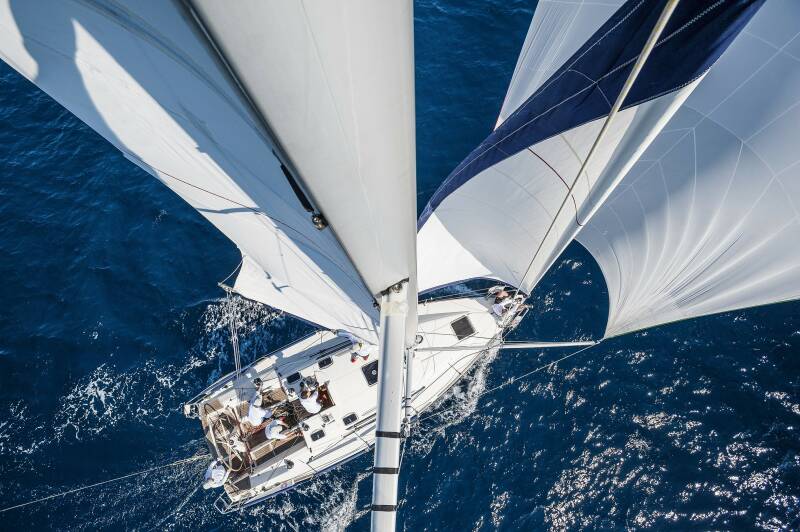
The Yacht Sailing Terms
- Berths/beds - a term used for a sleeping capacity of a yacht.
- Bimini - a weather-resistant fabric stretched over a stainless-steel frame, fastened above the cockpit of a sailboat or flybridge of a power yacht which serves as a rain or sunshade.
- Boom - the other pole that is connected to the mast under 90 degrees.
- Bow - the front part of the sailing yacht.
- Capsize - when a ship or boat lists too far and rolls over, exposing the keel. On large vessels, this often results in the sinking of the ship.
- Deckhand - a person whose job involves aiding the deck supervisor in (un)mooring, anchoring, maintenance, and general evolutions on deck.
- Draft - the depth of a ship's keel below the waterline.
- Galley - a term used for a kitchen on the yacht.
- Genoa sail - a front sail, located in between a mast and a bow of a yacht. It has the shape of a half balloon.
- Head - a toilet or latrine of a vessel.
- Helm - a steering wheel on a yacht, usually located at the stern.
- Keel - a central structural basis of the hull.
- Mast - a big “pole” that rises over a sailing yacht and holds a mainsail.
- Mainsail - a sail of a triangle shape, located in between a mast and a boom. Used for sailing into a harbour and for that reason is a main sail, but it is not the largest sail on a yacht.
- Moor - to attach a boat to a mooring buoy, post, or dock.
- Passarella - a little “bridge” on the stern which helps enter from a pier.
- Port side - when observing yacht from the helm, the left side of the yacht.
- Rudder - located beneath the boat, a flat piece of wood, fiberglass, or metal that is used to steer the ship (shape of a fin). Larger sailboats control the rudder with a wheel, while smaller sailboats will have a steering mechanism directly aft.
- Saloon - a central area in the yacht, with a galley, eating table, captain’s desk and sofas.
- Starboard side - when observing yacht from the helm, the right side of the yacht.
- Stern - the back part of the yacht.
- Winches - devices around which ropes are wrapped, used to lift sails and all kinds of heavy objects.
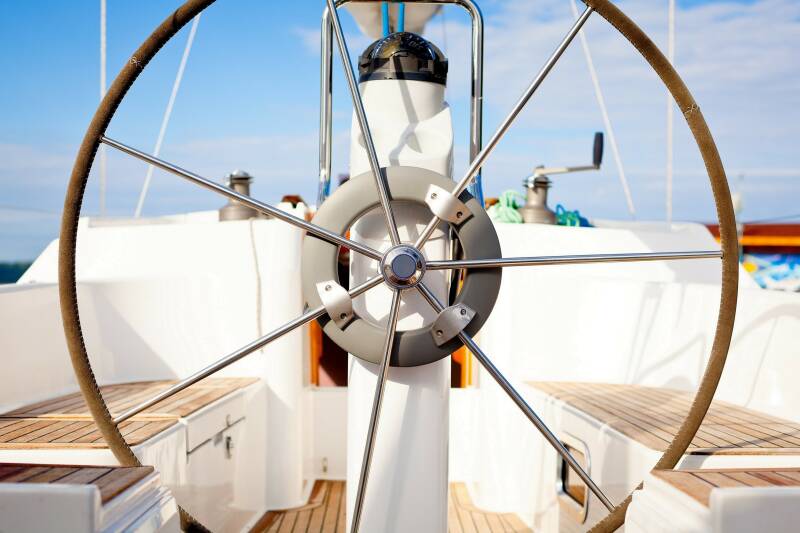
Terms While Sailing
- Apparent wind - during close hauled sailing into the wind, you will feel the wind into which you are sailing and the one that is created by the movement of your boat. That wind is called apparent wind.
- Beam Reach - at the point when the wind is filling sails under the angle of 90 degrees, we are in the beam reach position of sailing.
- Broad Reach - where the wind is entering our sails under the angle between 91 and 170 degrees, we are in the broad reach position and sailing downwind.
- Close Hauled - when wind is filling the sails under the angle of 45 degrees, we are in sailing close hauled position.
- Downwind - sailing in the same direction as the wind is blowing, or position in which wind is blowing into the stern of your sailing yacht.
- Heeling (leaning) - a lean caused by the wind's force on sails.
- Jibing - an opposite manoeuvre to tacking, performed when the stern of the yacht is pushed through the wind, so that wind changes from one side to another. Jibing is less performed than tacking since it is more dangerous and complex.
- Leeward - in the direction from which the wind is blowing towards the yacht.
- Reach - a point of sail from about 60° to about 160° off the wind. Reaching consists of "close reaching" (about 60° to 80°), "beam reaching" (about 90°) and "broad reaching" (about 120° to 160°).
- Reef - to temporarily reduce the area of a sail exposed to the wind, usually to guard against adverse effects of strong wind or to slow the vessel.
- Sheet - a rope used to control the setting of a sail in relation to the direction of the wind.
- Tacking - manoeuvring sailing yacht bow into the wind, so that the wind blowing direction changes from one side to the other, from starboard to port or vice versa.
- Vessel - a craft for traveling on water, usually a larger boat or ship.
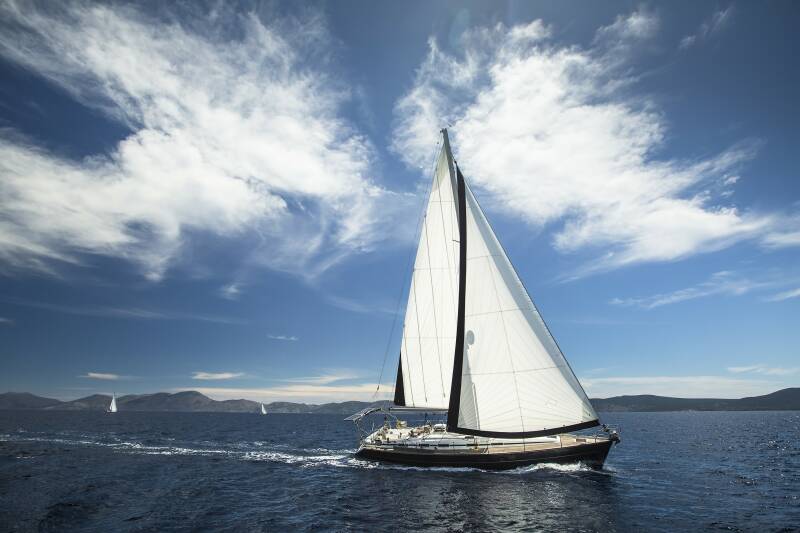
Sailing Equipment Terms
- Drysuit – fully-closed suit protecting you from harsh conditions on the sea during rough weather.
- Life jacket – a personal flotation device, a piece of equipment designed to assist a wearer to keep afloat in water.
- Nautical charts - a graphic representation of a maritime area and adjacent coastal regions.
- Safety harness - a form of protective equipment wrapped around hips and quadriceps that is an attachment between a stationary (safety fence/lane around the sailing yacht) and non-stationary object (sailor). It is protection against falls from heights or a fall off the boat.
- Sailing gloves – very similar to cycling gloves by design (open-finger gloves), used to reduce impact of the friction between hands and ropes which you are holding while sailing.
- Sailing jacket, pants, boots, shoes – made of several materials which are wind- and waterproof. You can find a whole variety of equipment depending on the conditions in which you will be sailing.
- Sunglasses - they must have UV protection and it would be desirable to be polarized.
- Watches - main prerequisite is that the watch is waterproof
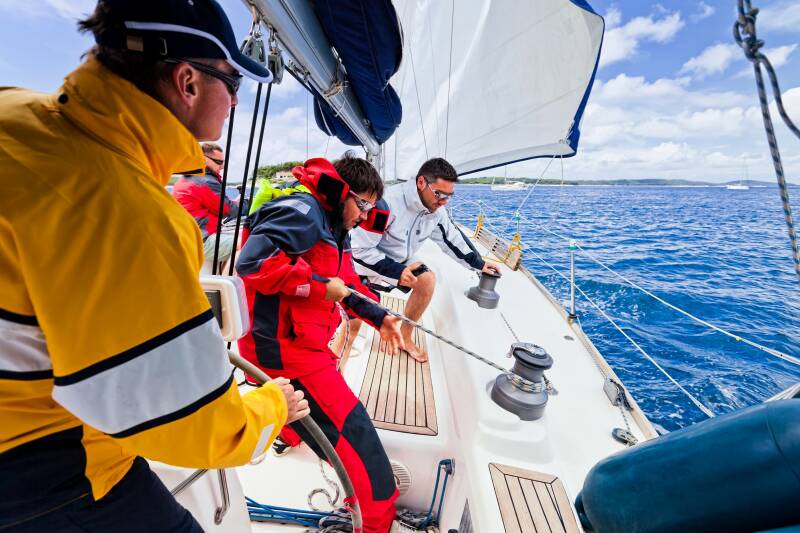
- Abandon Ship - an imperative to leave the vessel immediately, usually in the face of some imminent danger.
- Aye, aye - Aye, aye - reply to an order or command to indicate that it, firstly, is heard; and, secondly, is understood and will be carried out ("Aye, aye, sir" to officers).
- Let go and haul - an order indicating that the ship is in line with the wind.
- Man overboard - a cry let out when a seaman has gone overboard.
Pirate Terms
- Ahoy - hello
- All hands hoay - everyone gets on the deck
- Batten down the hatches - a signal to prepare the ship for an upcoming storm
- Coaming - a surface that prevented water on the deck from dripping to lower levels of the ship
- Cockswain - the helmsman
- Dance the hempen jig - to hang someone
- Duffle - sailor's belongings
- Heave ho - instruction to put some strength into whatever one is doing
- Holystone - a sandstone that was used to scrub ships
- Jacob's Ladder - a rope ladder that was used to climb aboard ships
- Jolly Roger - the famous pirate flag with skull and crossbones on it
- Landlubber - a person who is not incredibly skilled at sea
- Old salt - a sailor that has a great deal of experience on the seas
- Poop deck - a deck that is the highest and farthest back
- Seadog - an old sailor or pirate
- Three sheets to the wind - someone who is quite drunk
- Yo Ho Ho - often used to express some sort of cheer but can also be used to call attention to the speaker.

We use cookies to provide you with the best service on our website. If you stay on our website, you consent to our Cookies Policy .
Tell us about your dream holiday, and we'll make sure you get a personalised offer at the best price on the market.
Thank you for your message. We will get back to you as soon as possible.
We're looking forward to learn more about your dream holiday. The more info you send us, the more detailed and personalized offer we can provide.
You have succesfully submitted the details of your sailing trip. Your detailed and personalized offer is on its way.
- Pontoon Boats
- Personal Watercraft
- nauticalknowhow
- Nautical Knots
- Tools and Calculators
Sailing Yacht A: Everything You Want To Know
The sailing yacht known as A was built between 2015 and 2016 by German yacht makers Nobiskrug based on designs by French architect Phillippe Starck that seemed to have made use of some naval architecture for inspiration. It currently holds the record for being the world’s largest sailing yacht, though, to be fair, it is technically a sail-assisted motor yacht as it is fully capable of moving under its own power rather than relying on the sails.
Who Owns Sailing Yacht A?
Russian billionaire Andrey Melnichenko, a man who made his fortune thanks to a coal company and a chemical company, is the owner of Sailing Yacht A as well as its older sister yacht the Motor Yacht A. Melnichenko has French designer Philippe Starck design both of the vessels for him.
How Big is Sailing Yacht A?
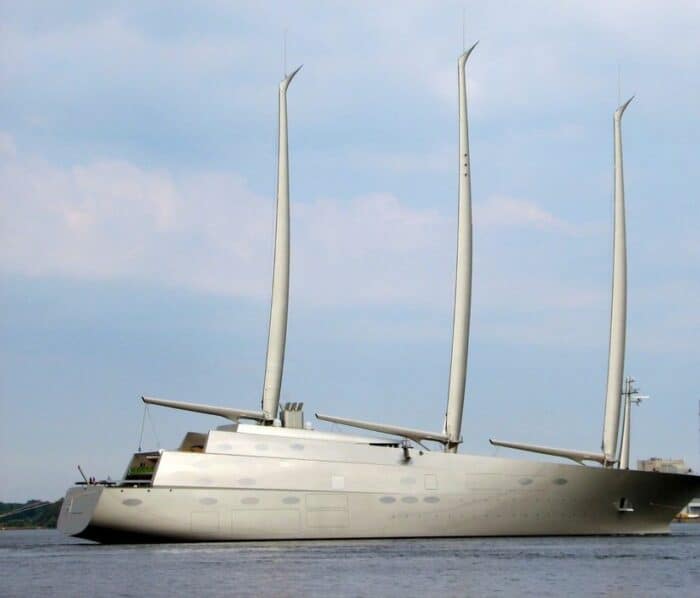
As mentioned, this is actually the largest sailing yacht in the world and it truly is immense. It earned the title of largest sailing yet specifically because of the length which clocks in at a stunning 468.5 feet. Not only is it the longest sailing yacht as a result of that, making it over 50 feet longer than its closest competitor, it qualifies as one of the largest yachts period, sailing or motor powered. It’s the 11th largest yacht in the world if you also include motor yachts.
Even aside from length, the stats are pretty remarkable. The masts, which are very hard to miss, are also gigantic. The main mast stands at over 100 meters or 300 feet tall. The entire boat has a listed height of 328 feet. That makes the A taller than the Tower of London or Big Ben.
The vessel is just over 81 feet wide and has a gross tonnage of 12,558 gt. The sails measure an incredible 3,747 square meters or 40,332 square feet. The sails can be controlled with an in-boom furling system. It also features a gimballed crow’s nest, accessible by an elevator, 60m high in one of the curved, carbon masts.
So It’s the Largest Sail Assisted Motor Yacht?
Technically, yes. There is not really a distinction made for more people between sail-assisted and sailing yacht.
Why Is it Called Sailing Yacht A?
Sailing Yacht A’s owner was being a little crafty when he came up with the name for the vessel. Like his earlier motor yacht, which is also called A or Motor Yacht A, Sailing Yacht A got the name it has so that it will always appear at the top of boat registry lists. It’s kind of like when businesses used to call themselves something like AAAA+ Plumbing so they’d be at the top of the page in the phone book, back when people still used phone books.
What is the Interior of Sailing Yacht A Like?
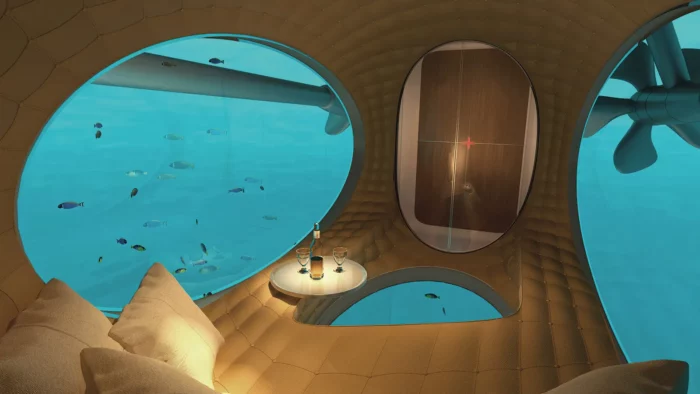
As you can imagine, there’s a lot going on in this massive yacht. To start, it’s a full eight decks. These can be accessed throughout the yacht with either a number of elevators or the free-floating spiral staircases. It’s rumored that there are cabins for at least 20 guests, plus a master suite on board.
There are oval windows throughout the vessel that are almost impossible to see from outside as they’re covered in a one-way film that allows passengers to look out but prevents anyone from looking in. Some of the rooms have floor to ceiling windows that simply can’t be seen from outside. It’s rumored that the master suite has a rotating bed and is presumably of a significant size as the master suite in the smaller Motor Yacht A was 2,500 square feet.
In terms of luxury amenities there’s plenty to choose from. The yacht has an underwater observation pod right in the keel with windows to the sides and below. The glass is one foot thick to ensure it can handle the pressure. It offers a view of the props in action which is unique and unlike observation windows you’d likely find on any other boats. And unlike many yachts which have launch vessels or jet skis in the garage, this one has a three-man submarine you can take out for fun as well as four tenders.
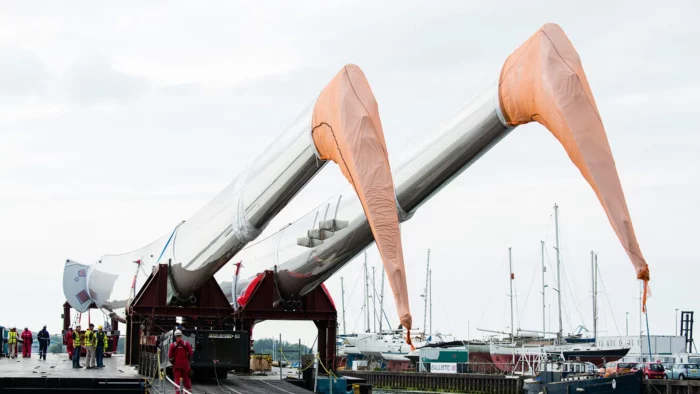
Melnichenko is known for throwing lavish parties – he’s had Lennie Kravitz and Snoop Dogg perform on board Motor Yacht A for him and his guests, and even had Whitney Houston and Christina Aguilera perform at his wedding some years ago, so it’s safe to assume the sailing yacht also features an extravagant party room as well.
A crew of up to 54 operate the vessel and much of that can be done easier than you’d think. Touch screen controls can power and maneuver the vessel at the touch of a button. Even the sails can be raised and lowered with electronic controls and a single person operating them.
In addition to the piloting of the ship, the crew run the yacht’s internal power plant, a professional galley the size of a kitchen you’d expect to find in a hotel, and other guest services like laundry and so on. These services and features are maintained across two of the boat’s 8 decks.
Much like any other yacht of this size, there is a helipad on the deck, and you can also find a large pool in the center of the deck as well. There are two other pools and all three are said to have current-generating technology to give them a more realistic ocean feel. As in his previous yacht, one of the pools has a glass floor so that you can see up into the pool from the deck below.
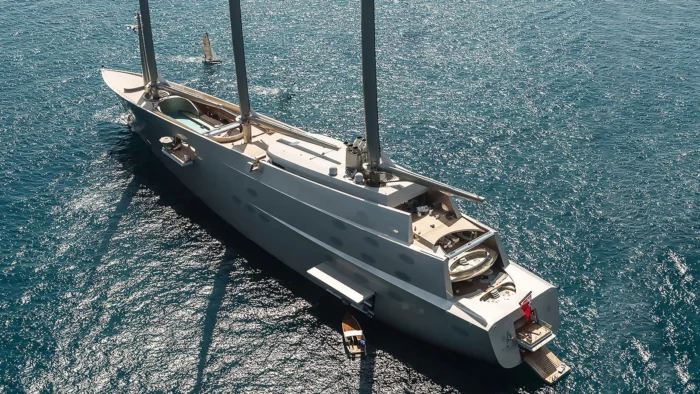
Many of the internal features have been kept under wraps as few people have had a chance to go on board the yacht. One particularly odd feature that has been noticed, however, is a chair on deck shaped like a giant, human head. Other glimpses of the interior have also shown off things like a large hot tub which has storage underneath it for a number of lifeboats, and the stunning blue navigation lights that line the exterior from bow to stern, just along the waterline.
The security features on the boat have not been disclosed, for obvious reasons, but Melnichenko previous yacht was rumored to feature everything from bomb proof glass to fingerprint scanners for enhanced security at key entry points.
Was Sailing Yacht A Seized?
In March, 2022, Sailing Yacht A was seized by Italian authorities in the Port of Trieste after Andrey Melnichenko was placed on an EU sanctions list following Russia’s invasion of Ukraine. Many Russian billionaires who have had ties to President Vladimir Putin had sanctions levied against them which resulted in assets being frozen or confiscated all over the world.
For unknown reasons, A was placed back in the water in June 2022 after being in dry dock for a few months. It was officially listed as being at anchor at that time with no further details about why the change in status. Melnichenko had stated at the time that he was going to contest the seizure of the luxury yacht but it’s unknown when or if that happened.
What Did Sailing Yacht A Cost?

Billionaires don’t always like to share their expenses with the world and Andrey Melnichenko is no different. He has not disclosed what he paid for the mega yacht and the yacht makers built it with a very thorough non-disclosure agreement in place that prevents them from sharing any of the particulars.
The fact that there has been no officially confirmed price tag doesn’t mean there hasn’t been some solid speculation about the price which has yet to be refuted. According to most sources, the yacht likely cost its owner somewhere in the neighborhood of €530 million which, at the time, probably worked out to around $578 million to $600 million US.
How Fast is Sailing Yacht A?
The props on the yacht are powered by twin MTU 20V 4000 ML73 main diesel engines or by electric motors or even by both together. It runs up to 2,050rpm, giving 2,800kW, and makes use of four generators instead of five to cut down on the overall weight. The generators are able to run down to 1,050rpm when it’s appropriate. Something called Superimposed System Controller (SSC) is able to constantly recalculate the optimal speed and determine the best combination of generators to use from moment to moment. This ensures optimal fuel and power usage while also limiting noise and vibration.
The result of all of this engineering is that the yacht has a cruising speed of 16 knots and a top speed of 21 knots.
The Bottom Line
Sailing Yacht A is the largest sail-assisted yacht in the world and, although the price is just speculated to be around $600 million, it’s clearly one of the most expensive yachts in the world as well. The exterior design is sleek and subtle and is able to hide many features including shell doors and windows while the interior spans 8 decks and has room for 54 crew and up to 20 passengers on board. The boat was seized by Italian authorities in 2022 and it’s unknown if or when the owner will get it back.
My grandfather first took me fishing when I was too young to actually hold up a rod on my own. As an avid camper, hiker, and nature enthusiast I'm always looking for a new adventure.
Categories : Yachts
Leave a Reply Cancel reply
Your email address will not be published. Required fields are marked *
Save my name, email, and website in this browser for the next time I comment.
More in Yachts
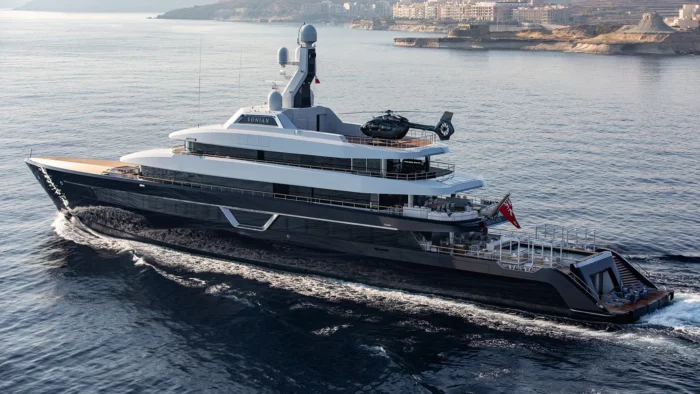
Lonian Yacht: An Insider's Guide
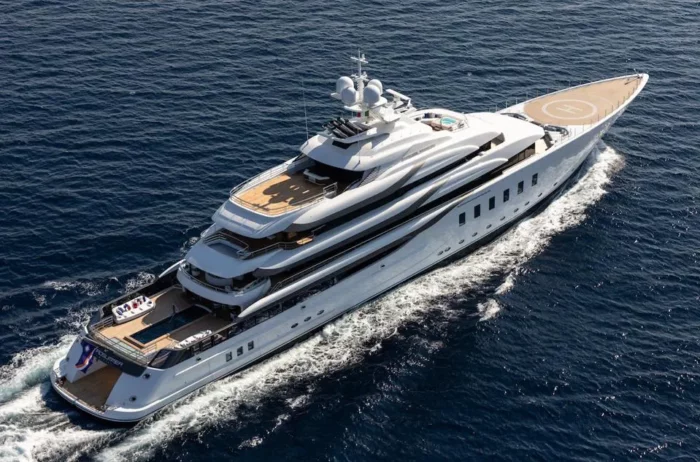
A Closer Look at the Madsummer Yacht
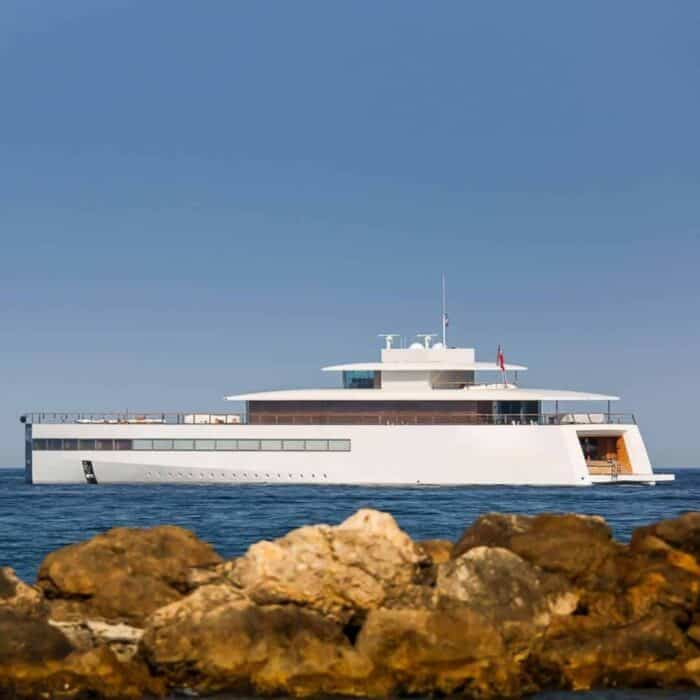
Your Insider’s Look at Steve Jobs’ Yacht Venus
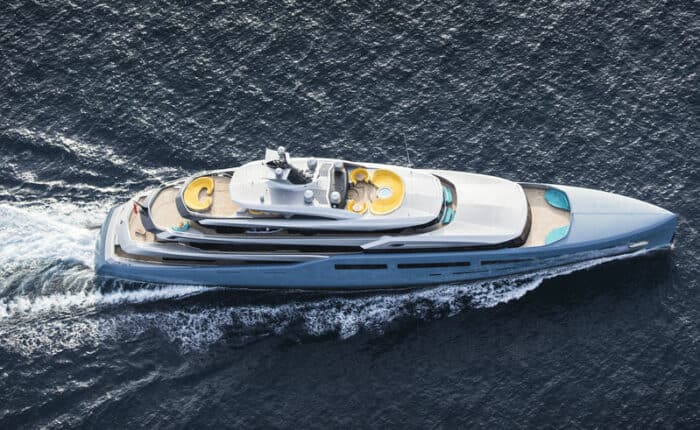
Your Insider’s Guide to the Aviva Yacht

The People’s Poncho Review and Ratings

Oru Lake Kayak Review

What Is A Gunwale?

131 of the Best Hawaiian Boat Names

167 Patriotic Boat Names
About boatsafe.
Established in 1998, BoatSafe is your independent guide into the world of boating, fishing, and watersports. We provide expert insights and detailed guides to help you find products tailored to your needs and budget.
Contact Boatsafe
- Address: 4021 West Walnut Street. Rogers, AR 72756
- Phone: (479)339-4795
- Email: [email protected]
Site Navigation
- How We Test
- Corrections Policy
- Privacy Policy
- Terms & Conditions
- Editorial Policy
- Affiliate Disclosure
Our Reviews

All content is © Copyright 2024. All rights reserved.
The unspoken rules about how to behave on a superyacht
- The superyachting world is very small, with only 5,800 yachts longer than 30 meters at sea.
- That insularity has bred a specific etiquette, which is often hard for outsiders to know about.
- These are the de facto rules of the most expensive billionaire toys, superyachts .

For the owners of superyachts , privacy is often the most valuable thing money can buy. It's one reason centimillionaires and billionaires pay eight or nine figures for a palace at sea, far from the prying eyes of land dwellers.
Even the most gossipy crew members should stay tight-lipped about the name of a former owner or charter guest, and many brokers shy away from answering benign questions.
That means that, aside from basic safety guidelines, most of the rules of superyachting are unwritten. The very few who need to know them — there are only about 5,800 yachts longer than 30 meters at sea, according to SuperYacht Times — already know them.
But if you do happen to be a lucky guest at a party on a billionaire's $500 million ship or find yourself included in a $1 million-a-week vacation, there are a few things you need to know.
After four days of touring superyachts that sell for as much as $75 million and chatting with the people who buy, sell, and work on them at the Palm Beach International Boat Show , Business Insider gleaned a few key edicts. Given the discreet nature of the industry, almost all the people we spoke with requested anonymity to protect their working relationships, but here's what they had to say.
Take off your shoes
While it's a basic rule for anyone in boating, it may come as a surprise to an outsider that no matter how rich you are or how expensive your heels are, in the vast majority of cases, you can't wear shoes on board.
It's partly for safety — you don't want anyone slipping on a wet deck — but partly to keep the yacht clean. So expect to see barefoot billionaires, and if you forgot to get a pedicure, bring a set of special boat shoes.
Don't make any assumptions about money — but know the signs
In the superyacht world, it's safe to assume almost everyone you meet is very, very rich, and many brokers and builders say you can't judge a book by its cover when it comes to prospective clients.
"It has nothing to do with how they're dressed," one broker told BI. "It's the biggest mistake you can make because a complete slobby-looking guy or couple could be a multibillionaire."
There are, however, a few clues. Watches are one; new footwear is another.
"Rich people always have new shoes," a superyacht expert said. But because of the shoe rule mentioned above, this tip probably applies only when they're on land.
Book your massage early
Wellness areas, including spa rooms with a massage bed or two and a professional-grade facial machine, are becoming must-haves on superyachts . Most have a customized spa menu and a crew member who doubles as a trained masseuse or beautician — and they're usually in high demand.
One captain said he'd implemented a booking system to ensure people weren't fighting for the same spots. A broker said sometimes masseuses would be so busy they wouldn't leave the small spa cabin for hours on end.
Related stories
So if you want to make the most of your relaxing time on board, reserve your pampering slot as soon as you get your welcome cocktail.
Pirates are more real than you'd think, and many superyachts have hidden safe rooms
While you might dress up as a fake pirate for an onboard theme party, there are very real ones — and other dangers — on the high seas.
In certain areas, including parts of the Indian Ocean and the Gulf of Aden, pirates are a cause of concern . In the Red Sea, owners are concerned about the Houthis .
Superyachts can come equipped with sonic weaponry, lockdown systems, and anti-drone protection. Builders are even designing safe rooms — which are apparently just as plush as the rest of the ship.
The longer the boat, the closer to $1 billion
While you can't judge a buyer based on appearances, you can judge them on the length of their boat.
One rule of thumb: If someone has a brand-new 50-meter vessel, chances are they have $1 billion to their name. If it's over 100 meters, expect the owner to have at least $2 billion. And for a boat bigger than that — like Jeff Bezos' 127-meter megayacht Koru — it takes many, many billions.
Money can't buy you everything
The world's biggest, most expensive yachts are custom-built by shipyards that produce only a handful of boats a year.
But no matter how many tens of millions of dollars clients are spending, there are things to which builders will refuse to say yes.
"In the end, the boat has our name," an executive from one of the world's biggest shipyards told BI.
They recalled a client who requested a yellow hull to match his Lamborghini . The shipyard declined, steering the client in another direction.
"If I don't like it, I don't build it. I finalize two or three contracts a year," another builder said. "If somebody can say your vessel is ugly, my reputation is bad."
Yacht crews are trained to make the impossible possible. A guest requests fresh caviar flown into the middle of the Caribbean? No problem. Fresh flowers every day while at sea? It'll cost you, but it can be done.
But they can't time travel, and captains and crew members say the thing that causes the most friction is when a client or owner wants to go from point A to point B — right now.
"The hardest request is when they want the boat in a place — yesterday," one captain said.
The best person to know? A friend with a superyacht
Superyachts are expensive to build and expensive to maintain . According to the industry standard, owning a superyacht will cost 10% of its new-build price annually. For a $100 million yacht, that's at least $10 million yearly going to crew, regular maintenance, insurance, fuel, and dockage.
Chartering, too, is costly . Beyond the list price, which can be hundreds of thousands a week, guests must pay for provisions, which are pegged at 35% of the charter fee, and are expected to tip between 10% and 20%.
So the most important unspoken rule of superyachting is actually that the only thing better than owning a superyacht is knowing someone else who does — and invites you along, of course.
Watch: Why it costs $1 million a day to run one of the world's biggest cruise ships
- Main content
Electric boats
Electric yachts.
- Solar Electric Boats
- Sunreef Yachts
Sunreef Yachts unveils new luxe solar electric Explorer catamaran with over 1,000 kWh in batteries
Sustainable boatbuilder Sunreef Yachts is adding a sleeker, lighter solar electric catamaran to its portfolio. The new Explorer Eco 40m is the company’s smallest electric yacht to date, but debuts with some of the most advanced technology, including Sunreef’s proprietary “solar skin”
Sunreef Yachts was established in 2002 in Gdansk, Poland where its shipyard and office still operate alongside a newer footprint established at port in the United Arab Emirates. From its very first year, Sunreef has been pushing the boundaries of sustainable marine travel, launching the world’s first 74-foot luxury oceangoing catamaran with a flybridge.
Today, hundreds of Sunreef Yachts are sailing waters across the globe, showcasing the company’s lineup of sustainable luxury catamarans, all-electric propulsion, and advanced solar panels. That current portfolio consists of eco-friendly sailboats and massive solar electric catamarans ranging from 60 to 100 meters in length.
Today, Sunreef shared it has gone smaller, introducing a new 40m electric yacht called the Eco Explorer.
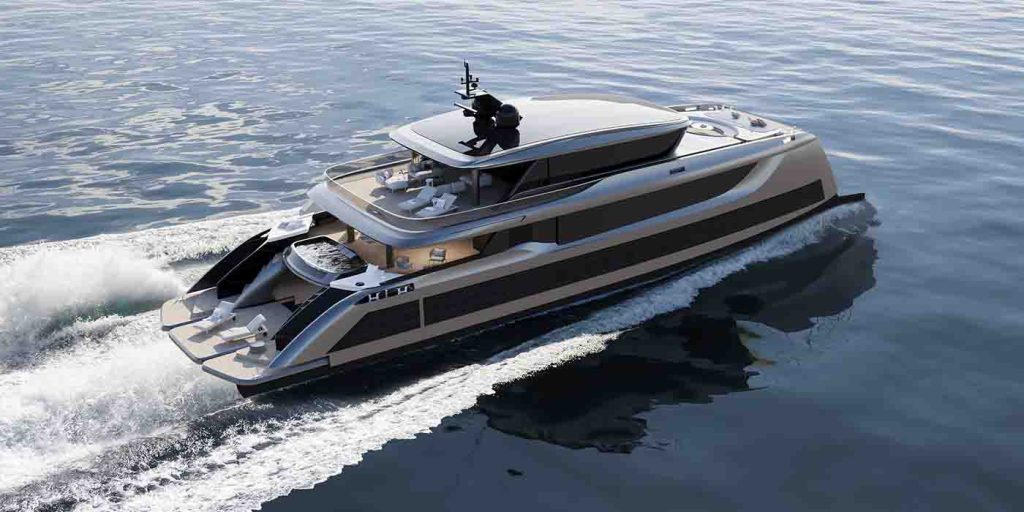
Sunreef Yacht’s latest electric catamaran is another beauty
Top comment by arno hayes.
I can't wait for ships to start using latent heat batteries with TPV. It might change the whole conversation about electric shipping. To a paradigm where nothing but electric shipping makes sense. Carbon variants can have volumetric energy density upwards of 1.5MWh/m3 (641kg). Though not all of that useable at maximum power output, I'm guessing. Let's call it 1MWh of useable energy. Pure guesstimate. You'd need 4000kg of 250Wh/kg LiIon batteries do the same.
I think a vessel as big as this would be capable of employing a storage system like that. And I believe that they will be suitable for trains and even larger airplanes. Maybe even trucks.
The company’s new Eco version of the 40m Explorer offers customers a sleeker and more sustainable design in a lighter marine footprint, all without sacrificing the luxury and comfort Sunreef is known for.
Sunreef shared that it favors catamarans over traditional yacht hull designs because require less energy to propel at sea – an important factor in marine electrification. The new Eco Explorer 40m features an ultralight composite build and a state-of-the-art electric powertrain consisting of two 540kW motors and two 550 kWh battery packs – giving the electric yacht the ability to cross oceans.
To support the all-electric powertrain, the Eco Explorer 40m is also covered in Sunreef’s proprietary solar skin, which utilizes every available inch of the hull and structure’s external surface to generate free, clean energy – more than enough to power the electric yacht’s onboard systems, HVAC, AV equipment and even its jacuzzi. Per Sunreef Yachts founder and CEO Francis Lapp:
Sunreef has been at the cutting edge of sustainable yachting since its launch. We are the only superyacht builder to have successfully developed the idea of embedding solar cells into large-scale fibreglass structures. But we’re not content to let technology alone do the work. Many elements of our wonderful, custom interiors can also be sourced from recycled and renewable materials. From hemp composite to recycled fabrics -it’s all up to the owner.
Sunreef says its new Eco Explorer 40m can accommodate 10 guests aboard, who can be taken care of by a crew of seven. Its motors deliver a cruising speed of 10 knots and a top speed of 14 knots. Build times are currently three years, and the electric yachts will be built at one of Sunreef’s ports in Poland or the UAE.
FTC: We use income earning auto affiliate links. More.


Scooter Doll is a writer, designer and tech enthusiast born in Chicago and based on the West Coast. When he’s not offering the latest tech how tos or insights, he’s probably watching Chicago sports. Please send any tips or suggestions, or dog photos to him at [email protected]

Choosing the perfect fit for your sail: Bareboat vs. Crewed Yacht charters
S etting sail in the open expanse of the sea might sound thrilling but challenging at the same time. Choosing the correct type of yacht for your voyage can be a dilemma, especially when there are so many types. But do they match your needs?
For this, the first step is to do your research. This will bring clarity to your decision on whether you want to set sail alone or need professional assistance. Choosing the correct type of yacht is crucial for a hassle-free sailing experience.
Yacht charters have endless types, but this article only gives you in-depth information about the broader categories of bareboat and crewed charters.
The goal is to help you make an informed decision by considering your group size, requirements, and priorities.
So let’s get started!
Types of yacht charters
Each yacht charter is tailored to meet different tastes and priorities, and choosing one can be overwhelming. Some of the most famous known types include:
Bareboat charters
Crewed charters.
- Skipper charters
- Luxury charters
- Cabin charters
This section will delve into the pros and cons of bareboat and crewed charters to help you plan the vacation you rightly deserve.
Chartering a bareboat gives you a thrilling experience of exploring the open sea. This type of yacht gives you freedom of navigation. This means you’re the captain, and you’re the crew.
However, the sailing period is pre-defined while renting a bareboat from a charter company.
Pros of bareboat charter:
- Flexibility
On a bareboat charter, you are the captain to set your itinerary. There is no need to stick to a fixed schedule, and you can make changes as you desire. This gives you the advantage of discovering more unexplored sites you can’t do on a busy cruise.
- Cost-effective experience
Bareboat charters provide financial leverage because you handle the boat yourself. So, heavy charges of the crew can be avoided easily. This cost-saving feature makes it an attractive choice for a memorable voyage across the sea.
- Customized experience
Chartering a bareboat allows you to be accessible to personalize your sailing experience. You can choose your dream destination and explore in solitude.
This provides an excellent opportunity to create precious, intimate memories with family and friends. So, your sailing experience will reflect your preferences and interests.
- Self-confidence
The independence that the bareboat charter offers comes with a bundle of self-confidence. You get an opportunity to manage life at sea on your own.
Getting out of your comfort zone of traditional traveling boosts your confidence automatically and motivates you to discover the hidden gem of places on your own.
Cons of bareboat charter
- Experience required
The independence that a bareboat charter offers seems attractive. However, it comes with a precondition. You must have prior sailing experience, and the necessary sailing skills are required for a self-sufficient adventure in the sea.
- Self-catering
Preparing meals, planning, and managing supplies can be daunting; on a bareboat charter, you are responsible for self-catering. It can be an enjoyable experience for culinary enthusiasts. However, it required precise planning and organizing to ensure self-sufficiency in the sea.
Even though an independent sail must be thrilling, nothing compares to having an assisted crew while you relax and enjoy the panoramic ocean scenes.
A crewed charter usually comes with a small crew of a skipper, a chef, and a hostess to assist you while you relax.
Pros of crewed charters
- Professional crew service
A skilled captain always makes navigation easier. By renting a crewed charter, you will gain a deeper insight into your destination through the crew’s local knowledge. Moreover, it ensures your safety and expert guidance in the sea.
This will not only make your journey smooth but memorable as well. Whether it comes to navigation or wanting a cocktail, the crew will be there to fulfill every need.
- Stress-free sail
The whole point of a vacation is to remain stress-free. While the crew handles all the operations and technicalities, you are left by yourself to enjoy. This provides an excellent opportunity to make memories with your loved ones or immerse in your surroundings without any worry.
With the crew catering to your every need, it leaves you plenty of time for exploration and relaxation.
- Customization
Crewed charters are famous for their adaptability. If you want to make any changes in your schedule, the crew is there to help you. You can plan intimate family gatherings and celebrations with your friends with the help of a limited but professional crew.
It is an attractive option because your voyage can be personalized to make it memorable. This adds a hint of exclusivity but at a reasonable price.
Cons of a crewed charter
- Costly
The exclusivity that a crewed charter offers comes with a price tag. Even though it ensures a wholesome experience with a professional crew, it can be a limiting factor for people with a budget constraint. So, careful evaluation is necessary when paying this much for an experienced crew to be on board with you.
- Limited privacy
Even though a professional crew ensures safety, their presence can be a compromise to your independence and privacy on the yacht. Your crew may influence your itinerary, and this results in less freedom than a bareboat charter.
However, these confusions can quickly be cleared out very easily. By communicating your needs effectively to your crew, they can maintain a balance between privacy and assistance.
- Itinerary limitations
The crew’s operations may impact your original plan, and these changes may not always be feasible. This can be frustrating sometimes but can be resolved by communicating with your crew.
However, the level of independence is different from a bareboat charter.
Now you can decide…
We have discussed the pros and cons of the primary two yacht categories. We now know that a bareboat charter stands out for independent sailors who seek a self-sufficient adventure. On the other hand, a crewed charter offers more relaxation as the operational and technical aspect of sailing is handled by crew members. At the same time, you relax in a hassle-free vessel.
These distinctions will help you make an informed decision while considering your budget constraints, prior sailing experience, and dream destinations.
Once you research, you can also contact yacht chartering companies for more information. Chartering companies worldwide, like 12knots.com yacht charters , offer a diverse insight into a fleet of yachts and sailing destinations.
So ditch the old travelling options, and for your next vacation, charter a yacht for a perfect getaway.

When does Below Deck Sailing Yacht Season 5 premiere?

Below Deck Sailing Yacht Season 5 has been on fans’ minds since the end of the explosive Season 4 reunion.
There was a major rift between Colin MacRae, Daisy Kelliher, and Gary King that left fans wondering what would happen next with the dream team.
The anticipation for Below Deck Sailing Yacht Season 5 was heightened after sexual misconduct allegations against Gary broke last summer, and he was removed from BravoCon.
Below Deck Sailing Yacht fans will soon have the answers to some burning questions about Season 5 as the premiere nears.
As Monsters and Critics previously reported, Captain Glenn teased the next season of the sailing show would hit Bravo airwaves this summer, but we have narrowed it down more.
When does Below Deck Sailing Yacht Season 5 premiere in 2024?
Below Deck, Season 11 has entered the back half of the season, and we are closer to Below Deck Sailing Yacht Season 5. Based on the mid-season trailer for Below Deck, the Season 11 finale will air on Monday, May 20.
That means Season 5 of Below Deck Sailing Yacht should premiere on Monday, June 3. The reason for the two-week break will be for one of two reasons.
One is a Below Deck Season 11 reunion that will air on Monday, May 27. At this time, we don’t know if a reunion will happen, but fans shouldn’t get their hopes for a reunion. Below Deck reunions seem to be a thing of the past.
If there isn’t a Below Deck reunion, Below Deck Sailing Yacht will likely still air on June 3 because Monday, May 27, is Memorial Day. Odds are Bravo won’t air the premiere of a new season on a holiday.
View this post on Instagram A post shared by Captain Glenn Shephard (@capt_glennshephard)
This means that in less than two months, Below Deck Sailing Yacht will be back on the air.
When will a Below Deck Sailing Yacht trailer drop?
While we wait for the Below Deck Sailing Yacht premiere date, Bravo should be giving fans a trailer for Season 5 in the next couple of weeks. Bravo tends to share more cast news and a teaser for new seasons about 4 to 6 weeks from the premiere date.
Below Deck Sailing Yacht fans can definitely expect a trailer before the end of April. Along with a teaser, we will learn about the cast or, instead, what we don’t already know.
Spotted filming in Ibiza! by u/Successful-Will-95 in belowdeck
Captain Glenn, Daisy, and Gary are all back for another stint on the Below Deck spin-off, as photos from filming last summer were leaked. The picture was revealed before the allegations against Gary, so it’s unclear as of now just how much Below Deck Sailing Yacht will portray him.
Are you ready for Below Deck Sailing Yacht Season 5?
Below Deck Sailing Yacht is currently on hiatus on Bravo. Seasons 1-4 are streaming on Peacock.

IMAGES
VIDEO
COMMENTS
As we focus on yachts and all that is unique and intriguing about them, the distinction between a yacht and any other boat will become clear. The Origin of Yachts. The word "yacht" is derived from the Dutch word for "hunter." The first yachts were exactly that: pirate hunters. The Dutch navy built swift sailing vessels that could sail ...
Many boaters use the terms "sailboat" and "yacht" interchangeably when they are actually quite distinct. A yacht is a larger boat or ship that is used for recreational purposes. The term "yacht" is of Dutch origin, and it was initially described as a small, swift sailing vessel used by the Dutch navy to track down and catch pirates. A boat, on the other hand, is a smaller vessel ...
A yacht ( / jɒt /) is a sailing or power vessel used for pleasure, cruising, or racing. [2] [3] [4] There is no standard definition, though the term generally applies to vessels with a cabin intended for overnight use. To be termed a yacht, as opposed to a boat, such a pleasure vessel is likely to be at least 33 feet (10 m) in length and may ...
Sailboat - A boat usually propelled by sail sailboat. Boat - A small vessel for travel on water. Yacht - Any of various recreational watercraft, such as a) a sailboat used for racing, or b) a large usually motor-driven craft used for pleasure cruising. Merriam-Webster Dictonary.
The average sailboat is smaller than the average yacht. For example, the average yacht measures 78 feet long and the average sailboat measures 30 feet long. Yachts can be as small as 40 feet long or they can even exceed 100 feet long. The world's largest yacht measures 511 feet long and it is unsurprisingly owned by a multi-billionaire.
The terms "sailing yacht" and "sailboat" are often used interchangeably, but there are some nuanced differences. While all sailing yachts are sailboats, not all sailboats are considered yachts as a yacht is classified as a vessel over 79ft. Sailing yachts are typically larger, more luxurious vessels, equipped with advanced amenities and ...
A yacht up to 100 ft. long is considered a yacht, while a yacht over 100 ft. long is considered a mega-yacht or superyacht. Yachts and mega-yachts are powered by either sail or engines. Yachts powered by a motor in an engine are usually the most popular choice for large groups or families due to them having more space and stability.
A sailing yacht (US ship prefixes SY or S/Y), is a leisure craft that uses sails as its primary means of propulsion. A yacht may be a sail or power vessel used for pleasure, cruising, or racing. [1] [2] [3] There is no standard definition, so the term applies here to sailing vessels that have a cabin with amenities that accommodate overnight ...
It also refers to a tender to a bigger boat or yacht. "Ship" is a large commercial boat, often used for distance travel and transport of goods or passengers - cruise ship, container ship, etc. "Yacht" is typically a larger boat with luxury amenities used as a recreational vessel— motor yacht, sailing yacht. "Superyacht" is a ...
A sailboat or sailing boat is a boat propelled partly or entirely by sails and is smaller than a sailing ship. Distinctions in what constitutes a sailing boat and ship vary by region and maritime culture. ... Sailing yacht with a fin keel. Most modern monohull boats have fin keels, which are heavy and deep, but short in relation to the hull ...
Big yachts cannot sail in shallow waters. If you are planning on sailing in places with shallow, shale filled, waters then a sailboat is the way to go. The Caribbean, for example, can be hard to navigate in a yacht. At least, harder than it would be with a sailing boat. On the other hand, a yacht can go to many more places than a sailboat.
There are many nuances and subtle differences between water vessel types, but below are some of the main differences. In general, yachts are either sailing or motor vessels used for pleasure. Yachts are often luxurious and equipped with an overnight cabin. Boats can be either propelled sail or a motor and come in varying sizes.
Cruiser/Racer sailing yachts are popular among sailors who want to participate in racing events, but also want to take longer trips and enjoy the comfort and amenities of a cruising yacht. ... He has also navigated throughout the world on various boats and yachts. His passion for sailing and knowledge of the sport shines through in his writing ...
Another key difference between yacht and sailboat crews is the size of the vessel. Yachts are typically much larger than sailboats, which means that they require more crew members to operate efficiently. Sailboats, on the other hand, are typically much smaller and can be operated with a smaller crew.
A yacht is a water vessel used for recreation, racing, or cruising, powered by sail or motor. A yacht can be a medium-sized water vessel or a small ship used for private and official purposes. However, there is really no standard definition because you can use this term for any watercraft with cabins, accommodations, and amenities for overnight ...
On YATCO.com there are currently over 1,000 sailing boats and yachts for sale, ranging from 14ft (4m) to 213ft (65m) located around the world - from the South of France, to the US, Indonesia, and more. With the oldest classic sailing yacht dating as far back as 1890 such as Sailing Yacht SKY, the 85ft (26m) true Gentlemen's yacht and ...
The boundary pushing Sailing Yacht A is a natural head turner. Delivered in 2017 by German yard Nobiskrug, Sailing Yacht A measures a total of 142.81 metres and is classed as a "sail-assisted motor yacht". BOAT rounds up the best photos of Sailing Yacht A from around the world.
30-70+ feet. Sailing yachts are graceful and use wind power. Motor yachts are speedy and powered by engines. Catamarans stand out with their steadiness and roominess - great for a leisurely cruise. Trawler yachts are great for long-distance trips because they're fuel-efficient and have comfy living areas.
The Sailing Yacht A, initially known as Project 787 'White Pearl,' was delivered by Nobiskrug to her owner, Andrey Melnichenko, in 2017. As the world's largest sailing yacht, she measures an impressive 143 meters (469 ft) in length with a beam of 25 meters (82 ft). Featuring eight decks, SY A can accommodate 20 guests and a crew of 20.
Mast - a big "pole" that rises over a sailing yacht and holds a mainsail. Mainsail - a sail of a triangle shape, located in between a mast and a boom. Used for sailing into a harbour and for that reason is a main sail, but it is not the largest sail on a yacht. Moor - to attach a boat to a mooring buoy, post, or dock.
The entire boat has a listed height of 328 feet. That makes the A taller than the Tower of London or Big Ben. The vessel is just over 81 feet wide and has a gross tonnage of 12,558 gt. The sails measure an incredible 3,747 square meters or 40,332 square feet. The sails can be controlled with an in-boom furling system.
The diaries of yacht owners: BOAT speaks to Marcus Blackmore, owner of CdM's 33-metre Nauta Air 110, and Bob Giles, owner of Nordhavn's 30-metre VivieRae. ... Having decided to sell the large sailing boat we thought a new motor boat would be our cruising choice for the next few years, so the CdM Nauta Air 110 became the one. We signed the ...
An experienced owner dialled up the race credentials of Oyster's comfortable 27-metre to create the 885GT. Elaine Bunting discovers a winning combination. SAILING ENERGY. After four years of work, this is the moment of truth for the new Oyster 885GT. It has been designed and built to thrill as the company's quickest yacht, and is minutes ...
Superyachts are expensive to build and expensive to maintain. According to the industry standard, owning a superyacht will cost 10% of its new-build price annually. For a $100 million yacht, that ...
Sailing Yacht A is a sailing yacht launched in 2015. The vessel is a sail-assisted motor yacht designed by Philippe Starck ... Boat International called it "the boundary pushing superyacht". The yacht is owned by Melnichenko through Valla Yachts Ltd. of Bermuda, ...
Sustainable boatbuilder Sunreef Yachts is adding a sleeker, lighter solar electric catamaran to its portfolio. The new Explorer Eco 40m is the company's smallest electric yacht to date, but ...
We have discussed the pros and cons of the primary two yacht categories. We now know that a bareboat charter stands out for independent sailors who seek a self-sufficient adventure. On the other ...
Based on the mid-season trailer for Below Deck, the Season 11 finale will air on Monday, May 20. That means Season 5 of Below Deck Sailing Yacht should premiere on Monday, June 3. The reason for ...
The Love Boat: A Top Travel Influencer This popular series (from the 1970s and '80s) introduced millions of American TV viewers to cruising, propelling the rise of passenger ships by showcasing ...
Harbour - Luxury Yacht & Boat WordPress is perfect if you like a minimal, clean and modern design. This is the best theme for yacht, boat, cruise, fishing firm, sail bureau, celebration, sailing, water sport, sailboat, regatta, surfing, windsurfing, parasail, cruise and yacht charter. It is perfect for boat and yacht booking websites.